












Integral and JLL are driving the evolution of the built environment through their comprehensive range of services and expertise.
JLL’s Strategy and Consulting services help clients develop real estate strategies aligned with their business objectives, while Project and Development Services bring visions to life with project management and development expertise.
Facilities and Property Management ensure the day-to-day operations of commercial properties run smoothly. Integral, JLL’s engineering business, provides end-to-end engineering and facilities services, ensuring buildings are safe, compliant, and efficient. By utilizing technology and data analytics, Integral and JLL provide market insights, predictive analytics, and performance metrics to optimize real estate portfolios.
Together, they shape the future of real estate and building performance.

Integral, JLL’s UK engineering business…

Let’s talk

MarkEvans Client Solutions Director Integral
 Nick Freeston Head of Consulting & Public Sector JLL
Nick Freeston Head of Consulting & Public Sector JLL



































Making the public sector thrive
How central government departments, local authorities and other public sector organisations can better deliver citizen services with Cloud wipro.com/cloud

The Labour Party has taken Blackpool South from the Conservatives in a by-election.
The result was a 26 per cent swing in favour of Labour, with Chris Webb taking the win.
He overturned a majority of 3,690 to defeat Conservative David Jones in the constituency, which was previously held by Labour from 1997 to 2019.
The swing of 26 per cent from the Tories to Labour was the third biggest in a by-election since 1945.
Conservative Party chairman Richard Holden described the local election results so far as “disappointing” and said his party needed to start talking about their successes and “vision for the future”.
Labour leader Keir Starmer said that the win has sent “a direct message” to prime minister Rishi Sunak that voters want change.
In terms of local election results, the Conservatives have suffered their worst loss in 40 years. Labour made strong gains in areas such as Hartlepool, Rushmoor, Hyndburn, Milton Keynes and Tamworth, where the Conservatives lost scores of council seats across the country including in some key general election seats.
Labour’s Sadiq Khan was re-elected for a historic third term as Mayor of London, beating Conservative candidate Susan Hall with a majority of around 275,000 votes.



Households in England will be able to put recyclables in one bin under simpler collection rules, the Department for Environment, Food and Rural Affairs has said.
They called it a “new, common-sense approach to recycling” that will make bin day easier.
The government said the same materials would be collected from homes, workplaces and schools across the country after apparent confusion caused by councils operating different systems.
Recycling minister Robbie Moore said: “We all want to do our bit to increase recycling and reduce the amount of waste sent to landfill –but a patchwork of different bin collections across England means it can be hard to know what your council will accept.”
He said the government’s plans for simpler recycling will end that confusion: ensuring that the same set of materials will be collected regardless of where you live.
People will be able to put plastic, metal, glass, paper and card in one bin. Similarly, food and garden waste will also be allowed to be cocollected.
Also, the government said they are supporting more frequent and comprehensive bin collections.
A minimum backstop means councils will be expected to collect black bin waste at least fortnightly, alongside weekly food waste collections.
Councils are also being actively encouraged...

Copyright compliance is not just a legal obligation, but an ethical one. Respecting the rights of creators and ensuring fair remuneration for the use of their work is a moral responsibility.
Visit link.cla.co.uk/local-authorities for more information

New first minister John Swinney has announced his cabinet, with Kate Forbes becoming the youngest ever deputy first minister.
Forbes, who was defeated by Humza Yousaf in the previous leadership contest, will also take on the economy portfolio and responsibility for Gaelic.
The new cabinet will consist of 11 cabinet secretaries, supported by 14 ministers, reducing the size of the government by four since the start of the year.
Shona Robison, who previously held the role of deputy first minister, will remain in cabinet with responsibility for Finance and Local Government.
Jenny Gilruth remains cabinet secretary for education and skills; Angela Constance remains cabinet secretary for justice and home affairs; Màiri McAllan remains in cabinet with responsibility for net zero and energy; and Fiona Hyslop remains cabinet secretary for transport. At the same time, Neil Gray remains cabinet secretary for health and social care; ShirleyAnne Somerville remains cabinet secretary for social justice; Angus Robertson remains cabinet secretary for constitution, external affairs and culture; and Mairi Gougeon remains cabinet secretary for rural affairs, land reform and islands.
The First Minister said: “Ahead of my appointment as First Minister, I committed to working collaboratively across the Parliament to address the pressing issues facing the people of Scotland...”



SOCIAL HOUSING
The government has said councils will be able to buy cheaper land to help build more social and affordable homes because of new reforms coming into force as part of the long-term plan for housing.
Councils will be able to buy land for development through the use of Compulsory Purchase Orders without paying inflated ‘hope value’ costs.
‘Hope value’ estimates the cost land could be worth if it was developed on in the future, meaning councils are forced to pay potentially thousands more to buy land for housing or developments and get stuck in lengthy disputes about costs.
The new measures will remove hope value in certain circumstances where Compulsory Purchase Orders are being used and make it cheaper and easier for councils to transform communities by building new homes.
Kate Henderson, chief executive of the National Housing Federation, said: “Enabling local councils to buy cheaper land through Compulsory Purchase Orders without paying ‘hope value’ will allow them to build more of the desperately needed affordable homes the country needs, in the right places for the people who need it most.
“To solve the housing crisis and unlock the land needed for these homes, these changes must sit alongside wider reforms to planning policy which should form part of a nationally coordinated fully funded long-term plan for housing.”
The Levelling-up & Regeneration Act 2023 allows bodies such as Homes England and councils using Compulsory Purchase Orders and looking to build, to apply to the Secretary to remove ‘hope value’.

For any stakeholders you want to reach get people focussed insights you can act on


Our experienced team of researchers provide the personal touch during your project, at every point, from designing the questionnaire through to presenting the findings and helping you get the insight that you can take action on





LEVELLING UP
Dundee has been announced as the first place in Scotland to benefit from a Levelling Up Partnership.
Dundee will be the focal point of a £20 million Levelling Up Partnership which is designed to root out inequalities by attracting investment and increasing opportunities for local people.
There are plans to build a new Dundee and Angus College campus to boost skills.
The investment aims to help tackle barriers to growth and turbo-charge regeneration, and the UK Government will be working hand-in-hand with local leaders to ensure this makes a major difference to people’s lives.
Levelling Up Partnerships were first announced in the 2023 Spring Budget. They are bespoke regeneration programmes that are targeted to areas that have previously been ignored.
Hull and Mansfield have previously been announced as beneficiaries in England.
Levelling up minister Jacob Young, said: “It’s fantastic to announce our tailored regeneration programme has been rolled out in Scotland for the first time, beginning by transforming the lives of people right across Dundee.
“This Levelling Up Partnership will allow us to tackle the historical issues faced by this city head-on, ensuring overlooked communities get what they need to fully reach their potential.”
The Levelling Up Partnership for Dundee includes: £3m towards the creation of new Grade A office development on the Waterfront; £2.5m for grassroots projects focused on enhancing opportunities for young people; more than £2m to improve access to housing and boost regeneration in the city centre, including by refurbishing vacant properties, and reviewing the condition of the local private rented sector...



Nottingham City Council is the worst local authority in England, while Torridge District Council in Devon is the best, according to government performance statistics, analysed by the Times.
The data, published by the Office for Local Government (Oflog), and analysed by the Times, reveals that some councils have recycling rates that are twice as good as others and that some authorities are failing to process half of planning applications on time while others are not late on a single one.
Ministers set up Oflog last summer to provide “authoritative and accessible” performance data to support improvement in local government.
The agency’s figures also show the extent to which councils are struggling with debts, with six local authorities already having declared themselves effectively bankrupt since 2021.
Oflog measures councils across 27 categories in five main areas: waste management, corporate and finance, adult social care, planning and roads.
The best councils were Torridge, East Cambridgeshire, Rockford, Malden and Staffordshire Moorlands.
The worst were Nottingham, Liverpool, Derby, Birmingham and Harrow.
Responding to analysis of the data from the Times, Cllr Abi Brown, chairman of the Local Government Association’s (LGA) Improvement and Innovation Board, said:
“Councils continue to face huge financial challenges, with individual local authorities facing competing demands on budgets that are often unique to their local area and specific circumstances...”
































£11 million of grant funding has been confirmed for public sector bodies in Scotland.
Leisure centres, schools and universities will be able to use the money to accelerate the decarbonisation of their properties.
Seven projects will share grants for clean heating and energy efficiency improvements totalling £11 million from the £20 million Public Sector Heat Decarbonisation Fund.
This is the first time direct grant awards have been made to public sector bodies instead of loans.
Scotland’s Public Sector Heat Decarbonisation Fund will eventually replace the existing Scottish Energy Efficiency Loan Scheme, which has been running since 2006.
The money is part of £200 million already committed to the public sector for energy efficiency and renewable heating over the next five years.
Patrick Harvie, zero carbon buildings minister at the time of the announcement said: “Heat from our homes and buildings is responsible for around a fifth of Scotland’s overall emissions so there is no route to delivering Net Zero by 2045 without tackling this. Not just our homes but our schools, universities, offices, hospitals and libraries also need to improve their energy efficiency and make the move to clean heating.
“We are absolutely committed to addressing Scotland’s reliance on direct emission heating systems that produce greenhouse gas emissions when we use them, which is why we have consulted on ambitious proposals for a Heat in Buildings Bill which we intend to bring forward during the current Parliament...”


Funding boost for renewable energy projects in Scotland: READ MORE
Cladding Remediation Bill passed in Scotland: READ MORE
ICO urges organisations to boost cyber security: READ MORE
Care worker visa applications plummet under new laws: READ MORE
New data reveals record numbers of homeless households: READ MORE
Report reveals action needed to tackle inequalities when it comes to physical activity: READ MORE
The BCC’s Quarterly Economic Survey – the UK’s largest and longest-running independent business survey – shows most firms reporting no improvement in investment levels, sales or cashflow in the first quarter of 2024.
After a slight rise in Q4, levels of business confidence have remained static. For the second quarter in a row, 56 per cent of businesses say they are expecting an increase in turnover over the next year.
With inflation likely to remain volatile over the coming months – the data also reveals that more firms expect hikes in their own prices, with staffing costs being the main pressure.
The survey, conducted between 12 February and 12 March, of over 4,800 firm across the UK – 92 per cent of whom are SMEs (fewer than 250 employees) – also reveals business performance across different sectors varies considerably.
The percentage of respondents reporting increased domestic sales stayed at 36 per cent, the same level as Q4. Likewise for the second quarter in a row, 22 per cent reported a decrease and 42 per cent said sales had remained constant.
But there were significant sectoral differences. 44 per cent of professional service firms said they had seen a boost in sales, whereas...

Forging a new reality with a design-led approach by Manish Bhushan, digital and cloud transformation senior partner, Wipro and Manish Gajbe, digital consulting partner, Wipro
transform their operations into a model that is centred around citizen experience.
Nowadays, citizens expect their public services to be easily accessible, just a few clicks away, similar to the convenience found in banking and retail. They expect to be put front and centre of an organisation’s focus, whether they’re accessing benefits or booking a doctor’s appointment. PwC research shows that 73 per cent of consumers consider customer experience pivotal to their purchasing decisions. Whilst the private sector has smartly recognised and heavily invested in enriching these consumer engagements, the public sector seems entangled by bureaucratic complexities, fiscal constraints, outdated infrastructures, and a limited understanding of today’s citizen’s needs. Furthermore, government departments often operate in silos, focused on their own domains and objectives, without acknowledging, or being willing or able to invest in the interconnectedness of citizen interactions across a number of services. This lack of collaboration and coordination results in disjointed and subpar citizen experiences. According to Salesforce’s Connected Government Report, only 54 per cent of customers believe that getting online assistance from Government is easier. Public sector entities must adapt to ever-evolving customer expectations and
Government departments in the UK struggle with many challenges when it comes to meeting citizen expectations. A lack of comprehensive approach, bureaucratic inertia, and legacy systems are just few of the hurdles that impede the creation of a seamless citizen experience. These challenges are further aggravated by the prevailing mindset that views government services as a one-size-fitsall solution, failing to recognise the diversity of needs and preferences among citizens. One of the critical issues facing government departments is their limited scope of vision. By operating within the confines of their own silos, many departments often fail to consider, research and comprehend the broader ecosystem of services that citizens engage with. As a result, they overlook opportunities for synergy and integration that could significantly enhance the overall citizen experience and deliver more of a holistic service. For example, integrating the benefits system with the tax system could streamline processes, reduce inefficiencies, and create a superior citizen experience. Similarly, the services provided by healthcare and social services departments are intertwined, and yet they often operate as separate entities.
Addressing this gap mandates a designled strategy anchored in the 4M principles: mindset, model, machinery, and method. This approach involves researching and understanding the unique needs and pain points of citizens, mapping out their journeys, and identifying opportunities for improvement.
The 4M principles:
Mindset: focus on driving the right behaviour in oversight of usage, the acceptance controls and the understanding of the implicit risks.
Model: operating model – consultative process re-imagination and remediation.
Machinery: key tools and accelerators. Strong partnership with market capabilities.
Method: impact-focused, citizen/user led, collaborative, agile & iterative method to deliver remediations.
Embracing a design-led approach nurtures interdepartmental symbiosis, dismantling operational silos. By breaking down silos and fostering cross-functional teams, departments can work in unison to deliver a holistic citizen experience. Moreover, design thinking principles empower government officials to envision the end-to-end journey of citizens, identifying touch points where integration can enhance efficiency and satisfaction. The adoption of the 4M principles ensures that innovative tools, agile technologies, and platforms form the cornerstone of this voyage – a voyage that converges with the ethos of effective models, methods, machinery, all hinged on a progressive mindset that trumps all limitations.
Wipro exemplifies this transformative journey, demonstrating the potential of innovative and seamless collaboration between the public and private sectors in its partnership with North Lanarkshire Council. This success story showcases the power of embracing this
transformative approach that streamlines processes and nurtures an innovative mindset. The seamless integration of modern technology solutions, ranging from efficient models to machinery, demonstrates a seamless alignment between the 4M principles and a design-led mindset. This holistic transformation empowered the council to not only provide ICT services, but also to embark on a journey of empowerment – a journey that simplifies citizen interactions, enhances service delivery, and elevates the overall experience. Through such strategic alliances, technology serves as a conduit for a significantly improved citizen experience – a testament to the synergy between design-led thinking and progressive technology strategies.
In this era of empowered, informed, and expectant citizens, the aspiration for a superior citizen customer experience must become a reality. The public sector must rise above the shackles of legacy processes and technology, embracing innovation to achieve an environment where citizens are not just beneficiaries, but active participants in the functioning of the government departments. The path forward is challenging, but it comes with the promise of a reimagined future – a future where a superior citizen experience is not a distant dream, but a reality that forms the core of government departments. For more information, download Wipro’s FullStride Cloud report here. J

2023 marked over a decade since The Public Services (Social Value) Act 2012 came into force. And what a decade it has been. What’s most remarkable is that the winds of change that have buffeted the sector haven’t stopped many organisations from ensuring that the vision set out in the Act is realised, with local authorities at the forefront of working with supply chains to deliver benefits for local communities.
CCS supports the public sector to get the best deal on the procurement of thousands of goods and services. Ensuring suppliers on our agreements are meeting the needs of potential customers, including on social value, is a key part in developing new solutions.
The measurement of social value that can be generated from procurement has become increasingly standardised across local government, including the introduction of the National TOMs framework, launched by the Local Government Associations (LGA) National Social Value Taskforce. TOMs (Themes, Outcomes, Measures) created a new, common language for social value, encouraging greater consistency in reporting. We are now seeing some evidence of more localised and regional
variations to the TOMS being adopted where local needs are more specific.
The five key themes that TOMs is built around are promoting local skills and employment; sustainable and responsible regional business growth; building healthier, safer, and resilient communities; decarbonising and protecting the planet; and promoting and enabling innovation.
Potential suppliers to the public sector should factor these elements into their thinking when bidding for contracts.
We are continually working with our framework suppliers to ensure our agreements better enable you to deliver your local social value outcomes.
CCS can ask suppliers to demonstrate how they work to ensure fair, inclusive and ethical employment practices. This could include evidence that they’ve advertised vacancies in a wide range of locations or that they’ve engaged with VCSE organisations about apprenticeships.
Visit our social value webpage for details of how to build policy considerations into your procurement. J
FURTHER INFORMATION
www.crowncommercial.gov.uk


From power requirements to landlord permissions, installing fleet, workplace or depot charging infrastructure needs careful consideration. Here’s what you need to know
When considering electric vehicles and assessing whether or not you need charging infrastructure installed at the workplace, it’s important to examine your fleet’s operational requirements. Can vehicles potentially charge at home or on the public network? Do you run ‘back to base’ operations when vehicles can charge at night? Or do you run a roundthe-clock service which will need a rapid DC charging for quick top ups?
If it’s decided that you need to install charging infrastructure on site, there are many points to contemplate. Firstly, you’ll need to understand your power availability. This involves finding out the size of your agreed supply capacity (ASC)
from your DNO, how much of that power you use, and what spare capacity remains for EV chargers.
This process is vital so you do not exceed your supply and risk a power outage.
If your site does have power limitations, there are ways to get grid connection upgrades via your district network operator, although this is an expensive move.
Other ways include using smart chargers with load balancing capabilities, or having the ability to generate your own power, such as solar, used with energy storage.
Load balancing systems/software will use real time energy monitoring to change the E
Thanks to their innovative, driver-focused electric vehicle charging solutions, Qwello has rapidly established a strong presence across Europe. Martin Hale, Qwello UK’s MD explains how they’re supporting local authorities and organisations to make EV charging solutions more accessible across the UK


Who are Qwello?
We’re a leading operator, owner, and technology developer of charging stations and proprietary innovative charging solutions for electric vehicles. With offices throughout Europe, Qwello is dedicated to revolutionising charging infrastructure.
What makes you different from other EV infrastructure providers?
Since 2017, our global CEO Henrik Thiele believed there had to be a better way to charge electric vehicles. That’s why we have developed our own innovative driver focused solutions to make the whole charging process easier and more accessible, setting us apart in the industry.
Where does Qwello currently operate charging infrastructure across Europe?
Qwello operates in several European regions, including Germany, Sweden, Spain, Poland, France, The Netherlands and the UK.
What about UK expansion?
Qwello made its UK debut in late 2022 with 50 world-class charging stations across The City of London. We’ve also secured contracts with Essex County Council, the Metropolitan District of Solihull, East Lothian, and other
soon to be announced wins, building over 300 additional charging points during 2024.
Tell us a bit more about Qwello’s charging solutions?
Our destination charging solutions are easy to find, reserve, access, connect, operate and maintain. Up to 22 kW of AC power is delivered through socket charging or 11 kW via an integrated retractable plug/cable satisfying the new accessibility standard PAS1899. They feature contactless debit/credit card access, built-in parking sensors, reservation function, and large bright screens showing tariff, status and instructions with intuitive animations.
Are there other key features?
Our solutions are fully funded at zero cost to local authorities and private car park owners. They are compatible with all EVs, exceed Public Regulation requirements and are compliant with OZEV’s schemes including, LEVI and ORCS. Qwello is also on Crown Commercial Service and Oxford City’s EV DPS public sector frameworks.
What is your commitment to sustainability and the environment?
As well as offering a fully funded, endto-end class-leading charging solution, we prioritise local communities when delivering EV infrastructure projects via the Social Value Act, contracting local organisations to install, commission, and maintain charge points. We’re also fully funded by environmentally focused Tiger Infrastructure, aligning with their commitment to sustainable and eco-friendly practices. M
www.qwello.uk

F maximum amount of energy that chargers can use based on availability and requirement of the site.
An important part of the EV installation process is getting a site survey. This will assess how EV charging can be installed and engineers will typically visit the site to assess power requirements and if any groundworks would need to be done.
A good chargepoint installer will be happy to do the above as part of their service.
If you don’t own the property, you will need to obtain consent from the landlord for chargepoints to be installed. This can be time consuming and may involve legal work, so it’s worth beginning these conversations as early as you can.

If you don’t own the property, you will need to obtain consent from the landlord for chargepoints to be installed
You will need to understand the different charging speeds to understand what is the most appropriate for you fleet.
Fast charging has speeds of between 7kWh –25kWh and is suited to destination, fleet, and overnight depot charging.
Rapid charging has speeds of 50kWh – 100kWh and can be used for quick turnaround charging.
Ultra-Rapid has speeds of 150kWh – 400kWh and is suited for public charging hubs, car parks, short-stay destinations and electric HGVs.
It’s also helpful to understand the difference between AC and DC charging.
A chargepoint with alternating current (AC) will get the alternating current from the grid and pass this on to the vehicle to convert to direct current and feed into the electric vehicle’s battery. The vehicle dictates the maximum AC charging rate, typically 7kW, 11kW and 22kW (though there are few vehicles capable at the highest rate).
DC charge points have the converter within the charger which means that the power is converted to DC before it is passed to the EV. The size of the converters will be much bigger than those inside a vehicle and therefore this results in a faster charge time. E








When choosing your chargepoint installer, it’s important to find out about their back office portals. A good back office system will allow you to monitor charging times, speeds, payments and conduct CO2 reporting. It’s also important to look at what aftercare the chargepoint operator offers for service and maintenance, including callouts for repair.

Once the chargepoints have been installed, the installer will claim the grant
There are various government grants for installing chargepoints, such as the The Workplace Charging Scheme (WCS) and The EV infrastructure grant for staff and fleets.
The Workplace Charging Scheme is open to businesses, charities, public sector organisations and small accommodation businesses, such as hotels or campsites (with 249 employees or less). Both have funding confirmed until 31 March 2025.
The WCS grant covers up to 75 per cent of the total costs of the purchase and installation of EV chargepoints and is capped at a maximum of £350 per sockets and 40 sockets across all sites per applicant.
The organisation requiring the chargepoints must apply for the grant, and if they are successful, will be emailed a voucher code which can then be given to the chargepoint installer. Once the chargepoints have been installed, the installer will claim the grant.
The EV infrastructure grant for staff and fleets is for small-to-medium-sized businesses in the UK with 249 employees or less. It can help cover the cost of wider building and installation work, such as wiring and posts, that’s needed to install multiple chargepoint sockets. The work can be for sockets that are to be installed now and in the future.
The scheme covers up to 75 per cent of the cost of the work. There is a limit of £15,000 per grant and you can get up to £350 per chargepoint socket installed and £500 per parking space. L
Supercharge your workforce.
The super portable, blazing-fast MacBook Air with M3 sails through the most demanding workloads. It’s easy to manage and securely runs the apps your teams use for everyday work, so everyone can stay productive and get more done faster.

Available for £29.50* a month
Securely trade in your current or ageing Mac or PC and receive a further £140 on top of the device’s residual value and purchase a new Mac, including the new MacBook Air – M3.
Trams is an Apple Authorised Reseller and Apple Authorised Service Provider. Trams|Econocom has over 30 years’ experience in providing an award-winning service, to enterprise and public sector clients. Trams|Econocom have been named as a supplier on Crown Commercial Service’s TePAS framework.
Crown Commercial Service supports the public sector to achieve maximum commercial value when procuring common goods and services. In 2022/23, CCS helped the public sector to achieve commercial benefits equal to £3.8 billionsupporting world-class public services that offer best value for taxpayers.
Using accredited companies we can arrange collection of your device(s) using tracked vehicles and vetted drivers to return to a centre where your device is wiped clean.
Combine the residual value of your recycled device(s) with the £140 Top Up and use the credit towards a brand new Mac.
Receive delivery of your new Mac, which Trams|Econocom can enrol into Apple Business Manager and your MDM.
In an era where corporate social responsibility (CSR) seamlessly integrates with essential business strategies, EvoEnergy’s collaboration with Big Yellow Self Storage (BYSS), powered by the advanced technology of REC solar panels, exemplifies a model of environmental stewardship

The project to design and install solar photovoltaic (PV) systems across BYSS’s portfolio not only showcases EvoEnergy’s expertise but also underscores Big Yellow’s commitment to sustainability, with REC’s innovative solar solutions playing a pivotal role.
Renowned for their rigorous testing standards, extreme environmental resilience, half-cut cell design using HJT technology, REC panels ensure the project stands at the forefront of renewable energy ventures.
A team of renewable energy engineers at EvoEnergy embarked on this journey with a clear mission: to harness solar energy to significantly reduce carbon footprints and energy costs.
This initiative extends beyond environmental gestures; it strategically aligns with Big Yellow’s CSR ethos, furthering their commitment to sustainability. The meticulous planning, selection of high-quality components like solar panels from REC Group headquartered in Norway and Fronius inverters from Austria, and the ethical manufacturing practices of REC panels underscore a dedication to excellence and responsibility.
The choice of REC solar panels was pivotal. Known for their durability, innovative half-cut cell design using HJT technology, and superior
performance under shaded conditions, REC panels ensure long-term, efficient energy production. This technological edge, coupled with our comprehensive strategy, has set a new standard for sustainable business practices.
The approach was bespoke, tailored to Big Yellow’s needs. Energy consumption was assessed, the potential for rooftop solar PV installations evaluated, and plans for future expansions, such as EV charging points, were made.
The project’s ambition was clear: to maximise renewable energy use to achieve tangible energy and carbon savings. Progress is notable, with 4.7MW of solar PV already installed across 55 buildings, marking a significant stride towards environmental goals.
Big Yellow’s facilities manager, Riaan, commends the project, stating, “EVO Energy has been instrumental in our journey towards net zero, delivering not just superior products but exceptional service, on time and within budget.”
The collaboration between EvoEnergy, Big Yellow Self Storage, and REC is more than a project; it’s a testament to the power of innovative renewable energy solutions and ethical business practices in driving forward a sustainable future. It exemplifies how companies can contribute to a greener planet while adhering to their strategic objectives, setting a replicable model for others to follow. M

There’s a significant number of municipal vehicles in operation across the country and local and central governments across the country are doing their bit to make them cleaner
Municipal vehicles are essential to the everyday functionality of life across the UK. We rely on them to take out our bins, sweep our streets and keep our sewage systems clean.
But, while they are necessary to day-to-day life, the carbon emissions of these vehicles must be taken into account.
A variety of different vehicles are covered by the term ‘municipal’ and include anything from bin lorries to road sweepers.
A lot of them are fleets and businesses, which are responsible for over half of new car and van sales in the UK according to the Society of Motor Manufacturers and Traders (SMMT ).
The government said they are committed to making all central government cars and vans fully zero emission by 2027.
Most municipal vehicles, especially the ones running on diesel, spew out emissions such as nitrogen oxides and carbon dioxide.
As well as this, the more fuel a vehicle uses, the more pollution they make. Therefore older vehicles consume more fuel than newer ones.
Government leaders across the UK and Northern Ireland have been investing more time and money into lowering the carbon emissions of these vehicles.
One way to do this is to switch to zero emission vehicles (ZEVs), as they generate both cost and emission savings.
Transport and Environment found that battery EVs emit three times less carbon E

In today’s fast-pa HARSH/Rasco’s c way we approach these sweepers a The answer is
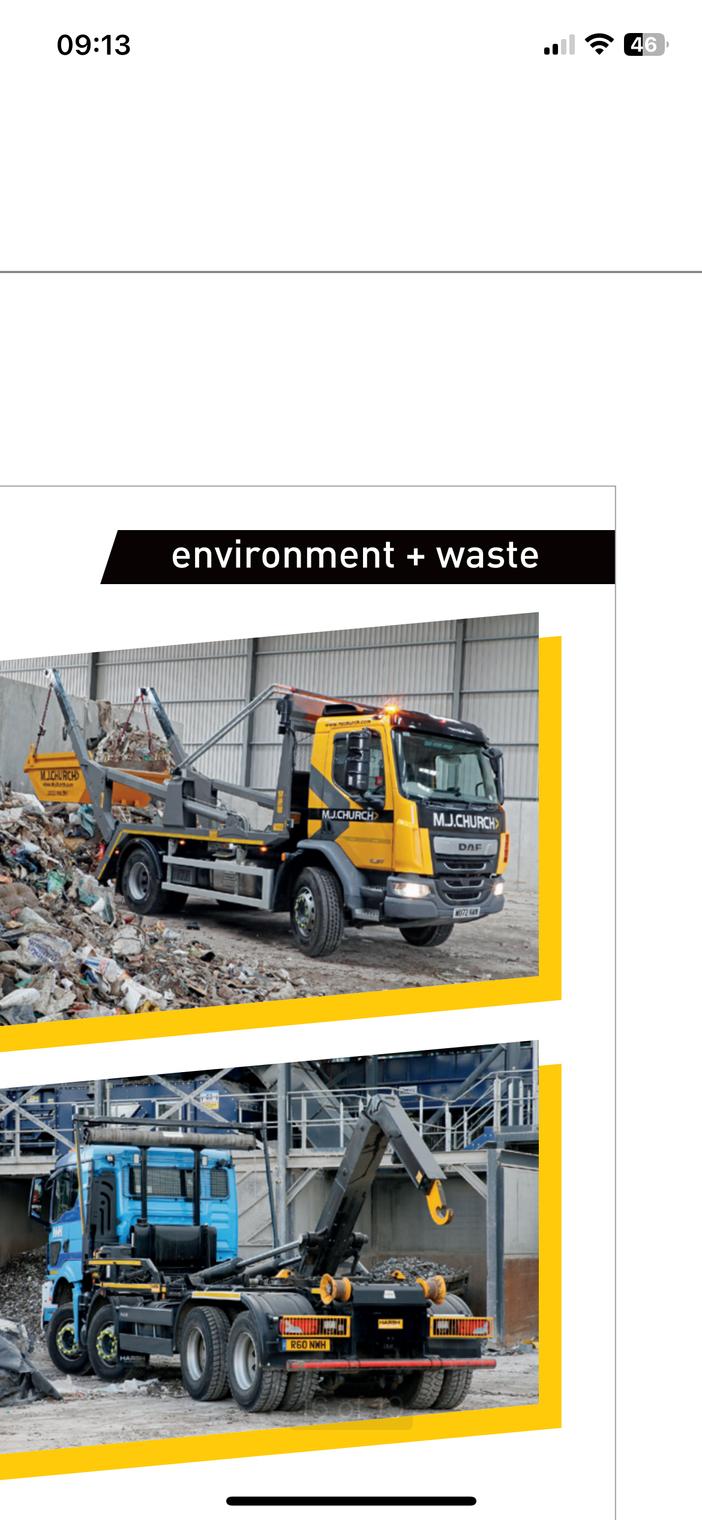


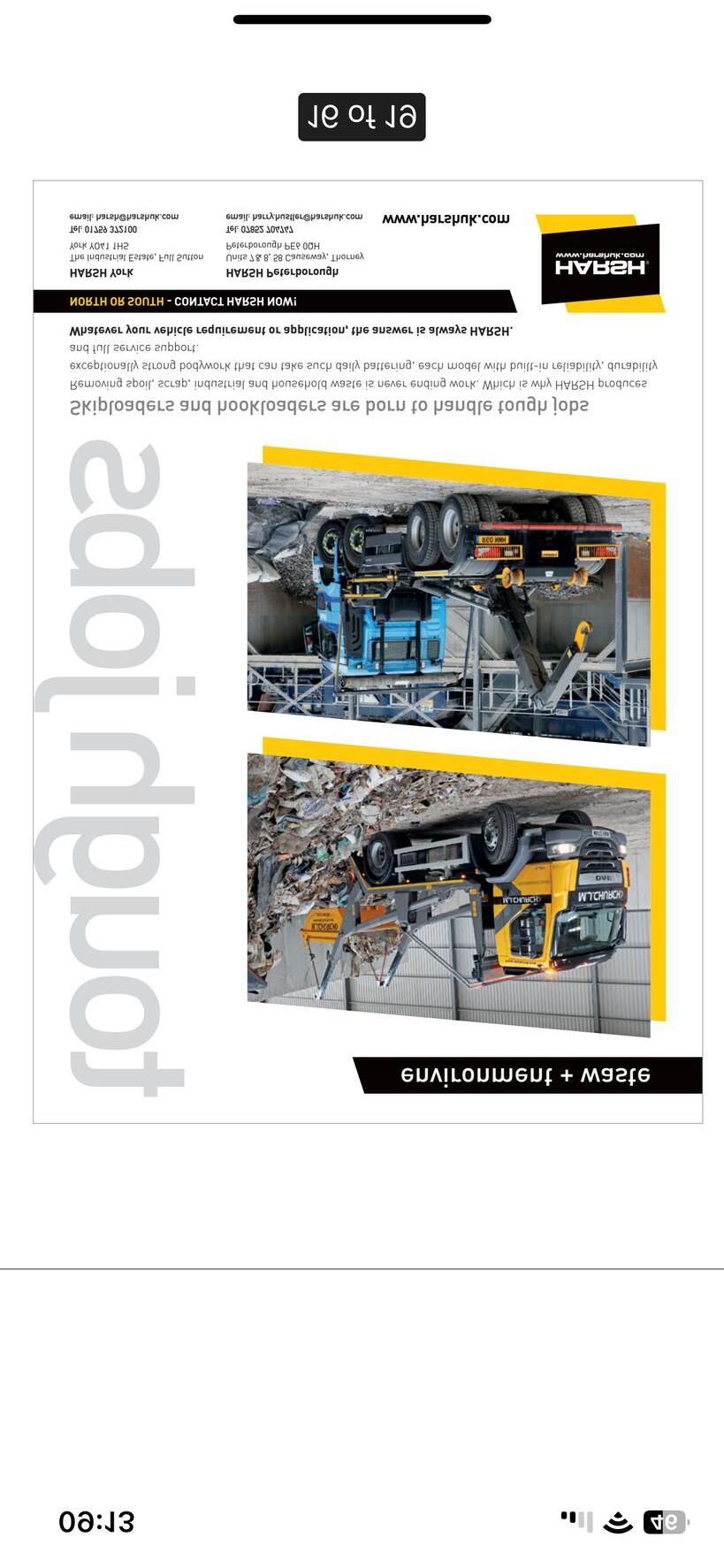
 HARSH/Rasco ‘LYNX CHARGE’ 5 tonne Compact Sweeper
HARSH/Rasco ‘LYNX CHARGE’ 5 tonne Compact Sweeper


dioxide than the equivalent petrol or diesel car, after factoring in emissions from electricity generation, car and battery production.
The Department for Transport said local authorities need to take a variety of steps in order to electrify fleets. They must identify which vehicles are suitable for replacement with

Some local authorities are working towards the aim of net zero using different methods
electric vehicles (EVs). Then they can decide on a procurement strategy based on whole life costs, as well as installing charge points at council depots and reviewing the options for charging.
Some local authorities are working towards the aim of net zero using different methods. For example, Rushcliffe Borough Council in South Nottinghamshire is converting its fleet of bin lorries to run on waste oil provided by supermarkets and other suppliers as part of their Carbon Clever strategy.
The Welsh government, however, has made an even bigger push to transform their fleet of municipal vehicles.
Back in February, for example, they secured a deal with FleetEV, an electric fleet provider, to reduce carbon emissions.
The Cardiff-based company signed to supply the Welsh government with 300 vehicles, including cars, vans, and specially adapted vehicles to a variety of regions across Wales. E










In Swansea, the council’s electric fleet includes more than 100 vans, cars, road sweepers and a refuse vehicle last year
F These vehicles are set to be used across the country’s public sector. Rebecca Evans, minister for finance and local government, said when announcing the deal: “It is essential we collaborate and use our existing funding and procurement levers in a more innovative and cooperative way to achieve net zero.”
She added: “This is a really good example of working together to achieve more.”
It is estimated to be the largest ever collaborative procurement of electric vehicles –and is expected to deliver savings of £660,000.
This is just one example of how the Welsh government is pushing for municipal vehicles to be more eco-friendly and emit less carbon than their diesel counterparts.
More specific to bin lorries in Wales, local councils have adopted an adorable way for the public to get involved with the acquisition of more sustainable vehicles.
In Denbighshire, North Wales, the council introduced a new fleet of recycling trucks with three of them being EVs. However, the

Denbighshire Council added an extra bit of competition; they let school children name them.
School pupils submitted more than 100 entries to the naming competition.
Around 20 vehicles are still awaiting a name, and the first results are in. Lord of the Bins came out on top (although the Terbinator will forever have a place in our hearts).
Outside of the capital, the Welsh government is continuing to push for municipal vehicles to cut down or eradicate their carbon emissions.
In Swansea , the council’s electric fleet includes more than 100 vans, cars, road sweepers and a refuse vehicle last year.
Andrea Lewis, joint deputy leader cabinet member for service transformation, said:
“Residents have always been very supportive of the council’s effort to reduce energy costs, contributing to tackling climate change.
“The electric vehicles we use are a daily reminder of a commitment that will continue for years to come.”
She said the fleet will help to cut pollution in city communities, reduce the council’s carbon footprint and ease pressure on fuel costs.
As well as this, Carmarthen County Council was awarded over £430,000 of funding from the Welsh government to procure 40 new EVs for front-line services.
Wales seems to be on the right track to transforming their municipal vehicles to more sustainable solutions and aims to reach net zero by 2050. L




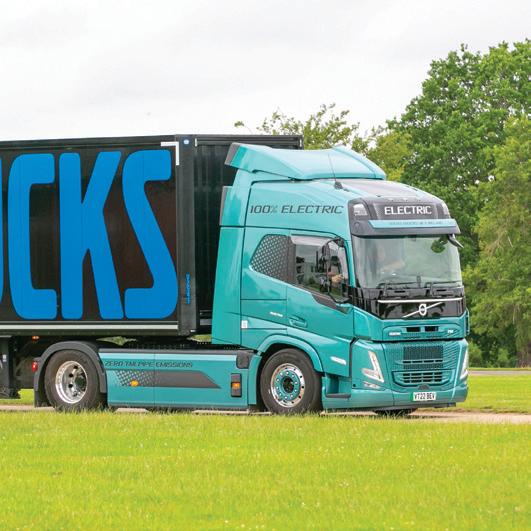

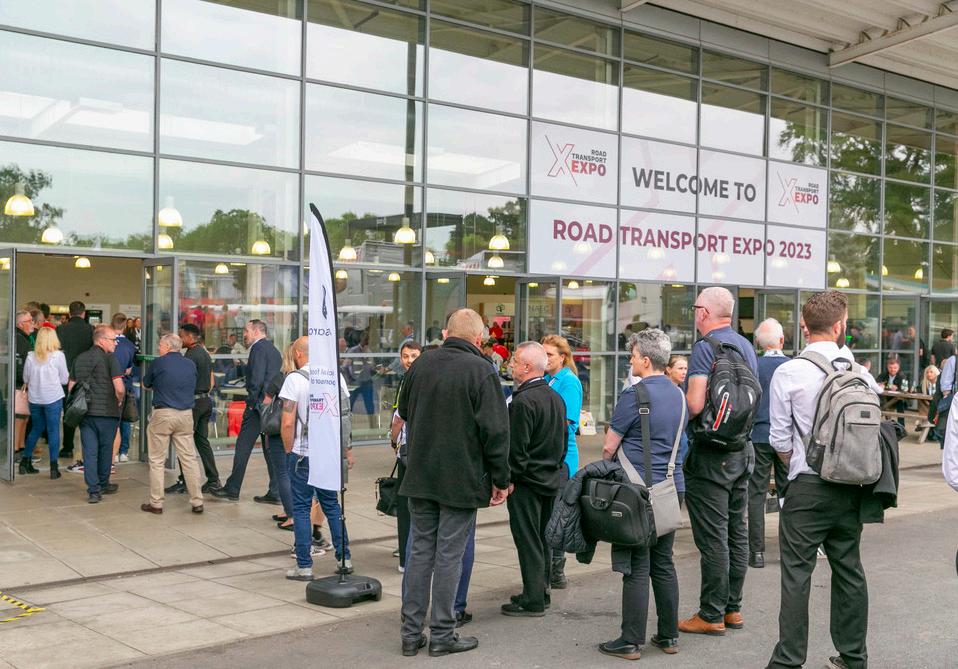



The must-attend event for anyone in road transport is back for 2024
Visitors heading to the Road Transport Expo (RTX) this summer had best be wearing their comfy shoes – there are more than 200 exhibitors already confirmed for the bumper trade show and the list is growing daily.
Taking place on 4-6 June at NAEC Stoneleigh, Warwickshire, RTX is back for its third year with its ‘all about the truck’ focus. The show will feature all eight major truck OEMs – DAF, Isuzu, Iveco, MAN, Mercedes-Benz, Renault, Scania and Volvo – alongside new entrants to the UK HGV market Sany eTrucks and HVS, in addition to van manufacturers Maxus and Ford.
You will also be able to find everything else you need for your business, from the smallest consumables through to tyres, specialist bodies, workshop equipment, tankers and trailers – all in one vast venue.
To make the most of your day at RTX, why not take a browse on roadtransportexpo.co.uk to help you decide which stands to put on your ‘must visit’ list? You can filter by a simple A-Z search of company names, or by the product type that interests you.
There will also be a range of exhibitors showcasing their expertise in non-product- E



F related areas such as training, compliance, finance/leasing, recruitment, insurance and law. Visitors in 2023 were delighted with the varied choice of exhibitors taking part in RTX, with 98 per cent rating the quality and quantity of stands to explore as ‘excellent/good’ and 96 per cent saying they were likely to visit the show again this year.
What else can I do at RTX?
Ride & drive:
If you hold a valid HGV licence and fancy getting behind the wheel of one of the latest diesel or alternatively fuelled trucks, then RTX is the

A free-to-attend seminar programme will be available for visitors during the show
show for you. We will, once again, be creating a dedicated route for visitors to try out vehicles on the day of their visit. If you prefer not to drive yourself, that’s no problem. There will be a team of professional drivers on hand to take visitors out for a spin to take in the driving experience from the comfort of the passenger seat.
Knowledge zone:
A free-to-attend seminar programme will be available for visitors during the show. You will be able to choose from a number of topical presentations, debates and interviews with industry experts, policy-makers and leading fleet operators. Sessions take place in one of the exhibition halls and you can join in the discussion on your mobile phone using Slido technology.
If you have attended before, then we would love to see you back at NAEC Stoneleigh this June. If you are new to RTX, then please do come along and join the buzz. It is completely free to attend. M
To register for your free ticket go to roadtransportexpo.co.uk
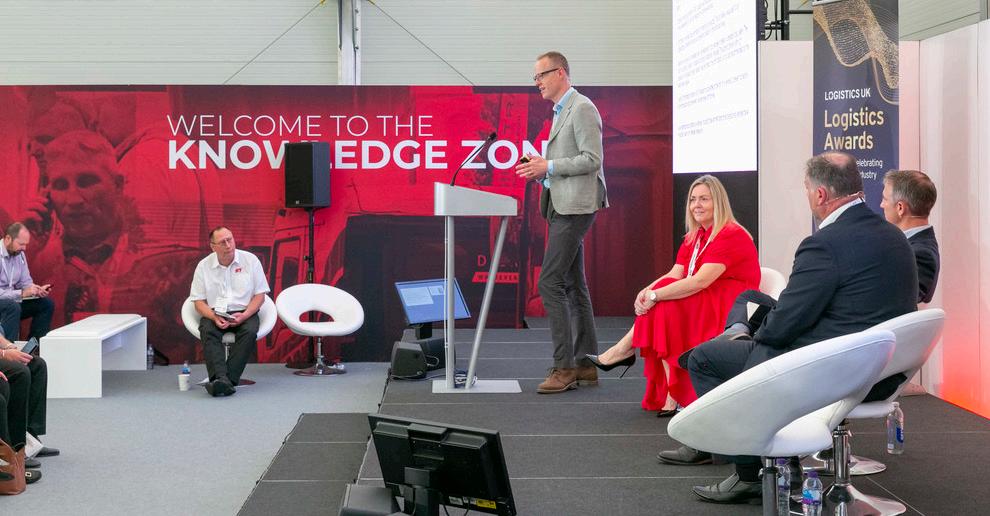
Decentralised generation and supply of electricity and heat for operation with natural gas, biogas, other lean gases, biomethane, and hydrogen.
• Increase profit
• Save energy costs
• Increase on-site resilience
• Full turnkey solutions
• Power range between 20 and 4,500 kW
• Containerised solutions to reduce noise
• Full-service solutions


2G Energy Ltd. | 01928 718533 | sales@2-g.com | 2-g.com
Buy your CHP today, have it converted to H2 tomorrow


Specialising in Combined Heat and Power (CHP) technology and manufacturing, 2G Energy Ltd is driving the energy transformation, offering extended service plans that redefine efficiency and sustainability with the advent of benefits from 2G R&D initiative both by design in hardware & software. One of the standout features of 2G Energy Ltd.’s service plans
is their dedication to uptime, which is enhanced with their predictive maintenance system I.R.I.S (Intelligent Reporting Information System) to help plan services and anticipate failures. This digital system monitors real-time data against commissioned data to distinguish any anomalies before they occur and compromise the prime mover’s ability to operate at its prime. By providing round-the-clock surveillance and best-in-class maintenance costs, businesses can rest assured that their operations remain uninterrupted, with 70 per cent of issues fixed remotely, therefore maximising productivity and profitability.
Committed to sustainability, their CHPs operate with various fuel sources including natural gas, biogas, biomethane, and hydrogen, thus reducing carbon footprint and ensuring future-proof solutions. In summary, 2G Energy Ltd.’s service plans represent a comprehensive approach to energy management, blending advanced technology with unparalleled support. As we advance towards a greener future, 2G Energy Ltd remains committed to decentralised heat and power systems. M FURTHER INFORMATION 2-g.com
Demand for commercial bin cleaning is running at an all-time high across the UK. With increased pressure from the Government for local authorities and NHS Trusts to step up their attention towards commercial bin hygiene (see Gov.uk under healthcare waste - waste storage, segregation and handling appropriate measures for permitted facilities) and written by the Environment Agency. The guidance shows that “commercial facilities must inspect waste containers used to transport waste before each reuse to make sure that they have been cleaned and disinfected, they are physically sound and the locking mechanism works. The methods you use for cleaning and disinfecting surfaces and containers
must: physically remove contamination; be capable of achieving disinfection across the broad spectrum of micro-organisms with the parameters used (time, concentration, temperature, quantity); not produce emissions of pathogenic bioaerosols or chemical agents, or must make sure these emissions are contained and managed appropriately; contain wash-waters within an impermeable area and either discharge them to foul sewer or dispose of them appropriately off-site; prevent run-off into external areas or to surface water drains; and prevent healthcare waste items from being discharged to water (including to sewer).
To successfully win contracts with local authorities and NHS Trusts, bin cleaning E














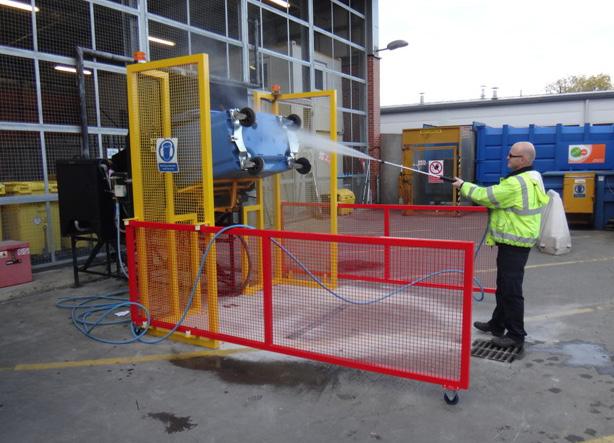
F companies across the country including the majority of our members are investing heavily in purpose-built mobile bin-cleaning equipment manufactured here in the UK by NAWBWapproved equipment manufacturers.
The National Association of Wheeled Bin Washers has seen increased demand for commercial bin cleaning from care homes, shopping centres, and hospitals up and down the country, this being especially the case since the COVID-19 pandemic. NHS Trusts are now including commercial bin cleaning within their waste strategies, insisting their waste contractors include regular onsite bin cleaning as well as the waste collection when entering into the tendering process.
To fulfil this requirement, NHS Trusts, local councils, facility management companies, and waste contractors are adopting one of two
Some employ the services of local or national bin
methods. Some employ the services of local or national bin cleaning companies which include our members, these companies must use purpose-built state-of-the-art bin-cleaning equipment, only use approved biodegradable germ and bacteria-killing chemicals and have professionally trained staff equipped with the correct PPE.
When subcontracting bin cleaning companies, local authorities and hospitals are requiring bins to be cleaned on a range of frequencies depending on the type of waste contained inside. Recycling and general waste bins tend to be cleaned once a month, while food waste bins in some instances are scheduled for weekly cleaning. Some bin cleaning companies using the industry’s most advanced equipment, are even washing the yellow hazardous waste bins onsite which is saving the NHS money against having these bins collected in a lorry and taken away to be cleaned offsite then returned at a later date.
Bin cleaning subcontractors are expected to responsibly contain the wastewater used in the cleaning process before disposing of it at a registered drop-off point approved by the local water authorities with legal consent to discharge at the property. E




Employing the services of a bin cleaning company works well for most facilities such as care homes, hospitals and shopping centres as the cleaning teams can work in conjunction with a waste contractor, arriving on site shortly after the waste has been collected allowing our members to hygienically and environmentally responsibly clean the bins before being returned across the sites to be put back into use.
The second method local authorities and NHS Trusts are taking to tackle the problem of dirty unhygienic bins is to purchase static and mobile bin-cleaning equipment to wash their bin stock in-house. As an Association we are proud that the two main suppliers of this type of equipment are approved members of the National Association of Wheeled Bin Washers and their directors sit on our board keeping us up to date with any industry developments. The UK has led the way in manufacturing commercial bin-cleaning equipment for the last couple of decades now with the very first static bin wash prototype being installed in Walsgrave Hospital, Coventry by Green Cleen (UK) Ltd nearly twenty years ago. Since then we have seen a growth of bin cleaning industries starting up across Europe, Australia The US and Canada
Static Bin Wash systems allow the customers to install electric versions of the machines


all using the UK model as a template and these overseas companies are buying their equipment largely from UK-based manufacturers.
Static Bin Wash systems allow the customers to install electric versions of the machines reducing their carbon footprint and unnecessary use of fossil fuel-powered engines.
Far safer for the operator and more risk-free, these machines are floor-mounted in a fixed position usually located next to the waste compactors. This allows operators to take the commercial bins to be emptied and then give the bins a quick wash each time before circulating them back around the site.
As an association, we are pleased to see local authorities and NHS Trusts starting to take bin hygiene seriously and understand that the Government is now even fining some NHS Trusts who do not clean their commercial bins regularly and responsibly. Unfortunately, there are no funds or grants included in this drive to encourage responsible commercial bin hygiene so we would like to see more financial assistance in the form of grants given to the NHS and local authorities to install commercial bin-cleaning equipment so we can see every hospital, care home and shopping centre across the country having their bins cleaned regularly so they can catch up with the private sector which includes clients such as airports, hotels, sporting and music venues across the UK who have been



There are no funds or grants included in this drive to encourage responsible commercial bin hygiene
employing bin cleaning services or investing in bin cleaning systems for several years now. M
If you would like more information on setting up a bin cleaning service or installing mobile or static bin cleaning equipment for your facility, contact the NAWBW at (01785) 281308 or email info@nawbw.co.uk



Kelly Tanks systems & customer support ensure sites are equipped to:
Comply with regulations
Minimise waste & environmental impact
Prevent contamination/pollution
Promote responsible waste management

Kelly Tanks offer cost-effective, easy-to-use solutions for dealing with wastewater onsite

Increasing environmental responsibilities and sustainability targets are driving the construction industry’s ongoing needs for cost effective, easy to use solutions for dealing with wastewater onsite. Sites also need quick replies, concise information, simple transactions, and deliveries without hassle.
Mark Stubbs, director of Kelly Tanks, has been involved in Water Treatment for over 30 years, leading him to establish Kelly Tanks, alongside Kelly Bryant, over a decade ago. Mark and Kelly have been guided by customer demand to provide the UK’s largest, most diverse fleet of concrete washouts and have further developed their range of water treatment solutions to include pH control, remote monitoring, flow proportional dosing and renewable energy.
Kelly Tanks’ product range and customer support is designed to ensure sites are equipped to comply with regulations; minimise waste and environmental impact; prevent contamination/pollution; and promote responsible waste management.
Kelly Tanks offer a selection of water treatment and concrete washout solutions for hire or purchase and onsite set up and familiarisation training if required. Their popularity and proven track record is a result of providing the kit you need, in the manner you want, at a price you’re happy with. Match this with their eager-to-please attitudes and above and beyond aftercare and it’s easy to see why their customers keep returning.
The key benefits you can expect from Kelly Tanks Equipment are that they are designed to meet the rigours of the construction
industry; they are fast and simple to set up; have small footprint equipment available; and the units can be linked to handle range of flows, pumps sizes & particle characteristics. They are easy to maintain and monitor; reduce off-site disposal costs and risk of pollution; and all equipment is easy to use.
Kelly Tanks take pride in the quality of their products and customer service, making them a real pleasure to deal with. M


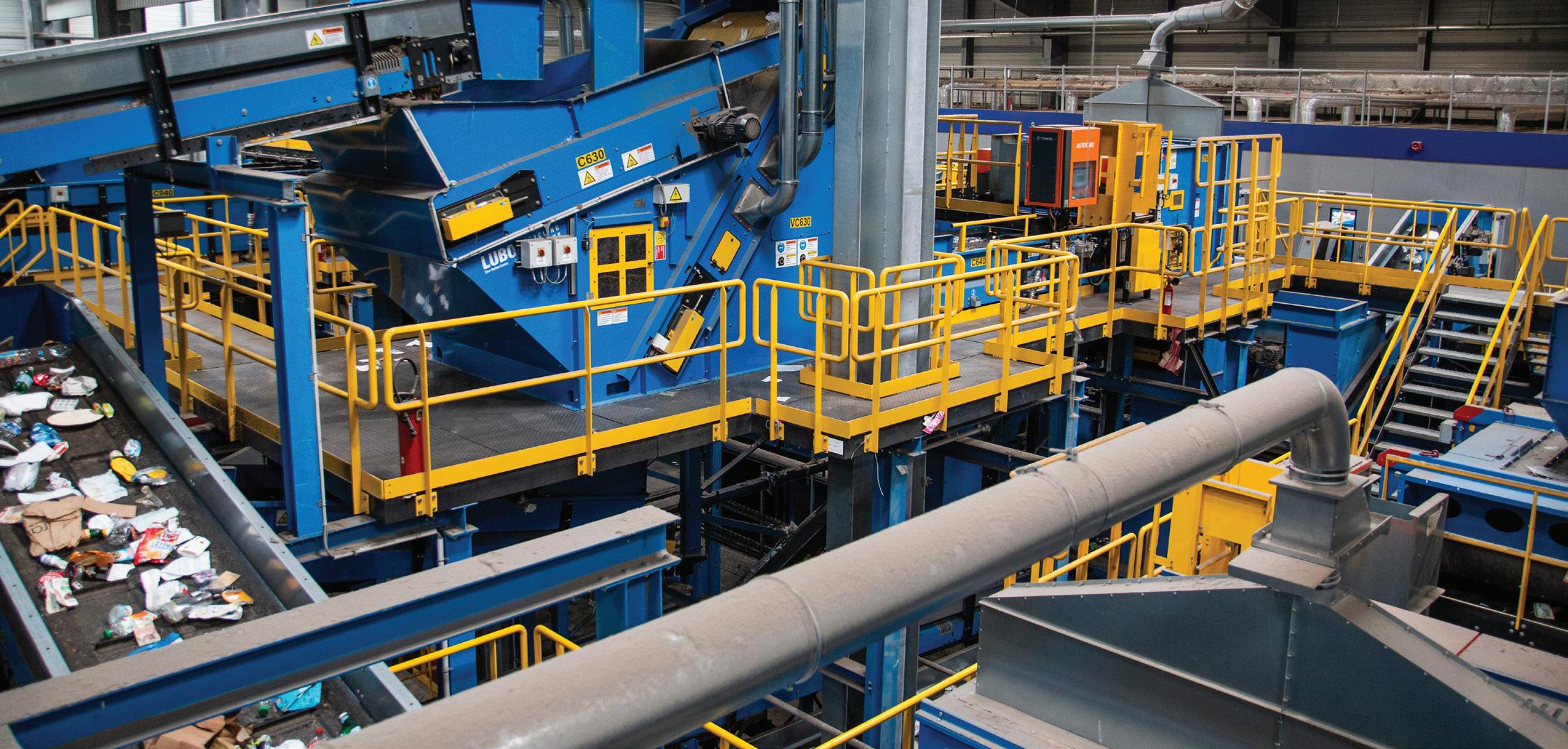

Eight West Midlands-based local authorities have joined together to manage a local recycling plant, improving recycling and bringing down costs
The challenge facing local authorities (LAs) regarding recyclate processing, is the legislative requirement to collect Dry Mixed Recycling (DMR) from residential kerbsides – while relying solely on the private sector to manage the processing, commodity sale, and residual disposal. In doing this, local authorities accept a number of risks without the ability to manage them. Chief among these are the escalating treatment costs driven by demand rather than operating costs; general uncertainty in the marketplace regarding the Future of Waste Strategy; instability and short-term commitments in commodity offtake; and the ever-evolving dynamics of consumer habits
and recyclate markets. Off the back of failed procurements, and an ever-growing frustration with the marketplace, a number of Local Authorities asked the question, ‘what else could be done’ to ease their waste management difficulties and concerns. The answer turned out to be, Sherbourne Resource Park (SRP).
The new, state-of-the-art Materials Recycling Facility (MRF) is the result of eight West Midlands-based local authorities working together to secure a stable, flexible, and long-term solution to the processing of their residential kerbside DMR. The uniqueness of the facility (SRP), can be seen throughout, including its operating company, Sherbourne E
Guardian Ultra is the latest intelligent personnel protection product from Safetech. It prevents accidents by detecting anyone in danger and automatically stopping the machinery.
The new system features extensive improvements using state-of-the-art technology, with digital monitoring and reporting. A PL-d has been validated by an independent test house. The aerial frame has been completely redesigned using glass-reinforced plastic, which is light yet strong.
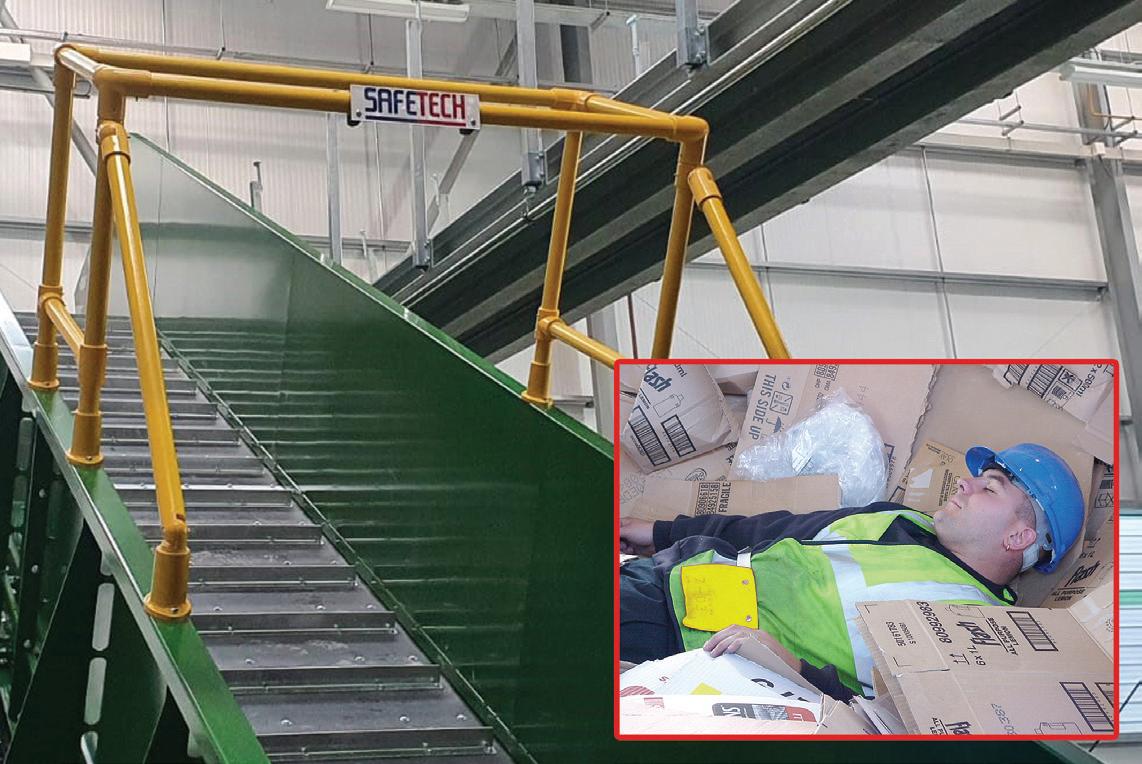







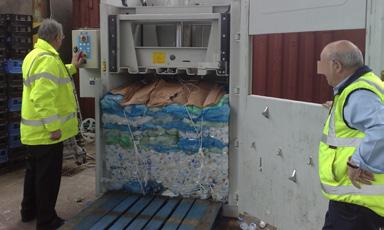

Sherbourne processes recycling from 1.5 million homes across the West Midlands
F Recycling, which is as cutting-edge as the technologies used to process the waste. All eight local authority shareholders wholly funded the facility, across what is a 25-year waste supply agreement seeing the partners work together in unison during this time. The eight partners who have invested in Sherbourne Recycling, and Sherbourne Resource Park are: Coventry City Council, North Warwickshire Borough Council, Nuneaton and Bedworth Borough Council, Rugby Borough Council, Stratford-on-Avon District Council, Solihull Metropolitan Borough Council, Walsall Council, and Warwick District Council. Their collaborative approach highlights a turning point in the industry, setting a new standard for local authority cooperation and innovation in waste management.
While Sherbourne Resource Park was built and modelled to serve the eight authorities as its main objective, and without the need for any commercial opportunities, the potential for this growth does exist. Any additional customers to the original eight would benefit themselves from incredibly competitive dividends and operating costs. Already, Sherbourne processes recycling from 1.5 million homes across the West Midlands, with both the appetite and capacity for growth.

Innovative technologies and flexibility
Sherbourne Resource Park has provided its partners with a recyclate management solution able to adapt and flex to changes in waste composition and legislation, while ensuring a focus on producing industry-leading levels of recyclate. Not only this, but the structure of the company, Sherbourne Recycling, and how it operates has provided all its partners with the agility and flexibility to adapt to a constantly evolving market. The 12,000m2 purpose built state-of-the-art facility is capable of processing an average 47.5tn of waste an hour, and up to 175,000tn per annum – lending itself to the phrase ‘Mega MRF’. E

Sherbourne is already capable of targeting plastic film from residential kerbside collections way ahead of forthcoming legislation that sees this as a requirement
F One of the MRF’s main selling points is the technology it uses. Alongside more traditional and expected waste separation tech such as trommels and screens lie optical sorters, and robotic arms which are controlled by AI technology. In fact, Sherbourne utilises 18 SamurAI® sorting robots, 14 optical sorters, and 14 AI units, which alongside the traditional tech result in industry-leading purity levels across all material factions. Because of the high-quality recyclate produced, Sherbourne can proudly claim that ALL of its materials stay in the U.K. to be reused – helping contribute to the company’s sustainability commitments and the wider circular economy as a whole.
The innovative aspect of Sherbourne Resource Park is certainly its use of AI technology and cloud-based software in the waste separation process. The AI is programmed to extract materials from lines which shouldn’t be there, determining materials through composition and product
recognition – all via data stored in a cloud. It is the AI system which identifies the distinguishing features of material composition in the same way as a human eye – including in dirty and changing conditions. Using a task-hierarchy system, the AI controls the robotic arms, ordering them to remove any residue or contaminants, achieving this at up to 70 picks a minute – almost double the average of a human picker. While a high degree of automation is used throughout the waste separation process, the human influence at Sherbourne is very much still a crucial part. While an average MRF may have dozens of human pickers across a line, Sherbourne can operate with just half-adozen. Instead, it has upskilled the jobs at its facility to the roles of engineers, technicians, and software controllers it calls ‘SCADA operators’, who together form the majority of the operations team which runs the facility on a day-to-day basis.
Having such autonomy across the process allows Sherbourne to adapt quickly to changes in residential material composition, government legislative requirements, or any forthcoming scheme introductions affecting the core recycled materials. However, planning for the future, Sherbourne is already capable of targeting plastic film from residential kerbside collections way ahead of forthcoming legislation that sees this as a requirement for its local authority partners – and SRP is


believed to be the first facility of its size in the country to be able to do so. An example of the facility’s flexibility is its correction around PET trays which in one stream were accounting for up to 30 per cent of total material in a bale. Asked by its offtaker to remove PET trays from a particular material stream, Sherbourne set about reprogramming its software and instructing its AI system, and over the course of just 48 hours, saw the results of PET in the same stream at under 3 per cent total.
Sherbourne Recycling operates with sustainability at its core, drawing power from its neighbouring Energy-from-Waste (EfW) plant, and sourcing energy from its photovoltaic cells on its roof. And, with zero residue going to landfill and an all-electric-powered forklift fleet, the company embodies the principles of a circular economy, minimising its carbon footprint and maximising resource efficiency. Beyond its technological prowess, Sherbourne also looks to prioritise social values, investing in employee training, apprenticeship opportunities, and working with community groups and educational facilities in the areas it services to teach the region about its innovative approach to recycling. As a real living wage employer with a generous benefits package, the facility exemplifies a holistic approach to sustainability that extends beyond environmental considerations to encompass social and economic well-being.
Expansion plans may include the development of additional facilities or the integration of new technologies
Looking ahead, Sherbourne Recycling is poised for continued growth and expansion, fuelled by the success of Sherbourne Resource Park and the company’s commitment to innovation in the waste industry. Expansion plans may include the development of additional facilities or the integration of new technologies to further enhance efficiency and recyclate quality. Moreover, Sherbourne’s unique and collaborative business model holds the key to success for Local Authorities across the country to take control of their waste management and emulate the company’s success in their own regions.
There is certainly no doubt that by leveraging cutting-edge technology, implementing a collaborative partnership across local authorities, and a steadfast commitment to environmental stewardship, that Sherbourne Recycling has redefined the boundaries of what is possible in recycling waste management. M
UKREiiF has quickly become a must-attend in the industry calendar for government departments and local authorities

But what is it, and why has it become the fastest-growing real estate and investment event in Europe?
The UK’s Real Estate Investment and Infrastructure Forum (UKREiiF) is an annual three-day event taking place in Leeds, the concept of which was created during the pandemic with an Advisory Group chaired by the late Lord Bob Kerslake, alongside other politician representation, including Manchester City Council’s chief executive Joanne Roney and the All Party Parliamentary Group for Regeneration and Development’s chair Gagan Mohindra MP. The mantra was clear from the outset: to create an event that connected people, places, and businesses to accelerate and unlock sustainable, inclusive, and transformational investment. It would be the place where regeneration was brought forward, but the type of regeneration that has communities and social mobility at the forefront. Skip forward to 2024, and the event is now into its third year, with 12,000 attendees expected and representation from almost 280 councils, almost every government department, and every combined authority and devolved administration in attendance.
What are they looking to achieve?
Firstly, there is the audience. The event is bustling with investors, from sovereign wealth funds to pension funds, all looking to deploy
capital into the UK. This, coupled with the high number of developers, housebuilders, and occupiers, creates the perfect ingredients to bring real opportunities forward. Torbay Council recently announced a £100 million development landed through UKREiiF, down to the facilitation that UKREiiF offers to truly connect investors, developers, and councils together to bring projects forward. And they’re not the only ones.
There is also an ever-growing international feel to the event In 2023, the UK Government brought a trade mission from Asia to the event, with the 60-person delegation visiting Manchester and London, with a two-day trip to UKREiiF in Leeds sandwiched in the middle. This was the perfect opportunity to showcase what the UK has to offer. And in 2024, the overseas interest is growing, with locations such as New York, South Africa, Illinois, Iceland, Turkey, Saudi Arabia, Austria, and Australia all confirming international representation from their countries. This will also enable thought leadership and knowledge sharing. UKREiiF will welcome the State of Illinois’s Department for Transport, creating a programme of activity to enable best practice and case studies to be shared amongst regions in the UK and the State itself.
The success of the event can also be attributed to looking beyond buildings
The built environment is crucial to all of our lives. It affects where we live, where we work, how we travel, where we get our healthcare, and so much more.
That’s why the event delves into almost every sector across the UK economy — not just looking at traditional assets like housing, infrastructure, and offices, but exploring the built environment across logistics/industrial, culture/ arts, aerospace, advanced manufacturing, life sciences, and more. All of these job-creating
sectors need the built environment and need investment, and therefore we’re placing these topics at the centre of our discussions.
The event is also having a major economic impact Cities and regions have often travelled overseas to attend events to engage with investors and developers, although it’s an open secret that the majority of the time they’re engaging with UK businesses at these events. Therefore, UKREiiF has created a unique offering in the UK — one that has an economic impact locally rather than overseas. The event has so far generated over £17 million in its first two years for the local economy in Leeds, according to a report by ARUP, while social measurement tool Loop stated the event created £3.3 million in social value. If we look beyond this, the event in 2024 is likely to create £20 million in local economic impact for the city of Leeds, creating an additional £3.5 million in social value.
Who’s involved?
The event is described as being ‘client heavy, meaning there are a large number of local authorities, government departments, investors, developers, and end-users who are easily visible and easy to engage with. From a government perspective, this includes Homes England and the UK Infrastructure Bank, who have dedicated areas alongside the Government Property Agency, Department for Energy Security and Net Zero, and the Department for Levelling Up, Housing, and Communities. In addition, local government is heavily represented, with most regions having their own dedicated pavilions or spaces, including Opportunity London, who represent all 32 London Boroughs, and the City of London, who team up alongside Manchester for their space. Others, such as the Oxford to Cambridge Pan Regional Partnership, Invest Newcastle, Cambridgeshire, and Peterborough Combined Authority, Western Gateway, Great South West, and the West Midlands Growth Company, and some of those with heightened visibility. And it’s clear that investors, developers, and
occupiers are easy to connect with — with pension funds like Legal and General and Phoenix Group, and occupiers like Aldi with large spaces to host delegates and connect. Wates Residential, Prologis, Mountpark, Tritax Symmetry, Harworth, Moda, Caddick Group, Muse, and British Land are other examples of those who can be found with dedicated areas and are looking to connect.
President of international investors Amro Partners said: “UKREiiF tells me that the UK is open to business, and as an investor, that is a fantastic message. The event brings together government ministers and officials, people from Whitehall, local authorities, investors, and developers; it’s a phenomenal representation of the real estate sector.”
Alan Denby, director of Pride in Place at Torbay Council, added: “Being at UKREiiF has enabled Torbay to have discussions with investors, developers, and occupiers, and from these discussions we’ve announced the preferred development partner to work with us on four key development sites worth over £100m to the local community, and that investment is a direct result of being involved in UKREiiF.”
Alastair Campbell, former director of communications for No. 10 Downing Street, said: “UKREiiF brings together all the different parts of the equation that are needed to regenerate regions and the economy successfully. And it’s changing people’s views of the industry world.”
Greg Ward, Principal Regeneration Office for Economic Development at North Northamptonshire Council: “I was unsure of the opportunities UKREiiF would bring, but I decided to attend, and our council was pleasantly surprised. There were a lot of learnings to have, but the dedicated investment and development facilitation sessions were excellent, and we had five prospects come from this, which has led to follow-up meetings in North Northamptonshire.” M

Hear

Discover

David Partridge Chair of the Governance Board for the UK Net Zero Carbon Buildings Standard
Hear from key members of the cross-industry standard coalition
Network and engage with members of CIBSE and other built environment industry experts


Take a lead on decarbonisation at the CIBSE Decarbonisation Conference on 26 June 2024 at BMA House, London
The CIBSE Decarbonisation Conference will delve into the ongoing efforts of the Chartered Institution of Building Services Engineers (CIBSE) towards decarbonisation, providing valuable updates on collaborative endeavours such as the UK Net Zero Carbon Buildings Standard.
Attendees can expect insightful discussions on the implications of this new standard for both members of CIBSE and professionals across related fields.
Hear from our key speakers including our keynote, David Partridge, chair of the Governance Board for the UK Net Zero Carbon Buildings Standard who will be delivering the latest updates on the UK Net Zero Carbon Buildings Standard and what it means to the industry and sector in whole.
The programme will also provide an overview of ongoing work focusing on key issues including retrofit, the future of refrigerants, district heating, and heat pumps, alongside others, featuring leading speakers in the industry.
Following our 2023/24 Presidential theme of ‘Taking a Lead’, the CIBSE Decarbonisation Conference is set to: lead on the cross-industry
coalition developing the UK Net Zero Carbon Standard; engage members of CIBSE and the wider building services sector on the latest in key topics for example, district heat networks and the future of refrigerants; address the questions and concerns in the industry; and debate the contentious issues that have come out of the development of the standard.
Readers of Government Business can attend this event with 10 per cent off the standard ticket rate. Use the code GBM at the checkout.J

ALERT PRO is the world’s first and only a real-time airborne asbestos detection and monitoring device

2024 is unfortunately yet another year in which asbestos has hit the headlines and the problem is not going away. The Health and Safety Executive (HSE) launched its ‘Asbestos – Your Duty’ campaign, The Times’ ‘Act Now on Asbestos’ campaign has focused on exposure in schools and ‘The First Annual Data Analysis Report into Asbestos in UK Buildings’ was released. The data for the analysis was collected over a six-month period from October 2021 to March 2022 and is concerning: of the 128,761 buildings inspected, 100,660 (78 per cent) were found to contain asbestos; within those 100,660 buildings, 710,433 items of asbestos were found; out of the 710,433 items of asbestos, 507,612 (71 per cent) were recorded as having some level of damage.
The report concluded that asbestos management was failing in a significant proportion of the premises.
Although asbestos was banned in the UK in 1999, asbestos legislation has not changed significantly since 2012 and the core technology and data used to manage asbestos risk has not changed for far longer. With this lack of change, you would think it safe to assume that as a nation we have the risk from asbestos under control, yet, the UK has the highest rate of mesothelioma in
the world and asbestos remains the UK’s greatest cause of work-related deaths with 5,000 per year. With the above in mind, should those in positions of responsibility look simply to comply with legislation, or should we be looking to do more than just meet the requirements?
Devon-based Alert Technology Ltd recently introduced the ALERT PRO, the world’s first and only a real-time airborne asbestos detection and monitoring device. The award-winning ALERT PRO range offers patented technology, which is changing the landscape of asbestos risk exposure. Representing the biggest technological step forward for decades the ALERT PRO provides users with real-time alarms to reduce exposure, timestamped data offering the ability to understand not only that asbestos is present but the why, the when, the how and the who.
The ALERT PRO 2000 Connected model provides real-time data in the cloud, instantly available to anyone who has access set up. Immediate notifications can be sent via SMS, email or 3rd party applications when risk is identified.
With governments, legislators and working groups trialling the product globally, could ALERT offer a much needed change to how asbestos risk is managed across properties and reduce deaths? M
www.alert-technology.com info@asbestos-alert.com

Avril Di Palma, business development manager at CarnDu Ltd and representative of the British Pyrotechnists Association explains everything you need to know about organising a firework display
Firework displays continue to be events that the public hugely enjoy and support, often bringing whole communities together in celebration. It’s very important however to remember that we are dealing here with explosives and as such these events require careful planning, organising and co-ordination between many factions to ensure that safety is the priority. A safely run show will ensure enjoyment for all those involved. Local authorities play a crucial role in commissioning and overseeing these events to make certain they run smoothly.
To begin with, it is important to note that this article is a brief guide only and readers should note the references to the following recommended guides produced by the
Explosive Industry Group that provide much greater depth on this subject: Working Together on Firework Displays (The Blue Firework Guide) and Giving Your Own Firework Display (The Red Firework Guide ).
At the very start of the planning process consideration should be given to choosing a capable contractor. Both the British Pyrotechnic Association (BPA) and the Explosives Industry Group (EIG) list members who are professional display organisers. The BPA for example also has an established training and accreditation structure recognised by City & Guilds for all their members’ firing staff. Their training covers everything required from a professional display company and is also recognised by the EIG. E


F Selecting a suitable site is the key
There are very many factors to site selection. As a minimum, consideration should be given to the following.
What is the anticipated number of people attending the event?
Is the site spacious enough to safely host both the spectators and provide an area for the fireworks? The site will need to be mapped out to include the firing area, a potential fallout area (for the prevailing wind and also if the wind is not from that direction), a safety area between the firers and the spectators, and the spectator’s area itself.
What type of surfaces are there at the site?
For example, if it is grass, does it require maintenance such as cutting or dampening down before the event?
Look at the proximity of residential areas, roads, livestock and other animals, trees and anything else that is potentially vulnerable. A professional contractor will assist you in deciding the suitability of the site and should provide you with a Risk Assessment, Method Statement, Operating Procedures and a
Once the decision has been made to have the event, it is vital that everyone affected by the show is informed
schedule of the proposed fireworks. There are also tools that display companies can use to determine if the site is suitable and CarnDu Ltd has developed the following modelling tools to assist firework companies with this.
ShellCalc© is a trajectory and fallout modelling tool for firework displays. It is particularly important in contingency planning and provides realistic modelling of both the trajectories of a variety of fireworks and their fallout/debris patterns depending upon firing angles, wind strength and direction. It also helps determine what is a safe distance and ensure the fallout area is large enough to accommodate the size and type of fireworks being set off.
EnvCalc© is for determining the environmental impact of a display. The calculator considers the chemical by-products of combustion and their environmental impact, as well as the extent of the combustion by-products released. There is also a comparison with other event aspects such as travel of the crowd, importation and transportation of the fireworks, use of drones etc.
SoundCalc© is for determining sound levels at distances from ground or aerial fireworks.
Once the decision has been made to have the event, it is vital that everyone affected by the show is informed well in advance so they are able to raise concerns but also be advised of the control measures that will be employed to minimise the impact upon them. On the day of the event, the selected firework company will monitor wind strengths and direction which may affect the type of fireworks that are eventually set off.
The display organisers also have a responsibility to undertake a Risk Assessment that as a minimum will cover: hazard identification, including those people (and structures) at risk and to what extent; risk evaluation: and identification of appropriate control measures designed to reduce risks.
A Risk Assessment should be site and product specific and consider the risks to operatives, spectators, buildings etc. Doing so will provide
the organiser with a clear indication as to whether the site is a suitable one.
Environmental issues play an important part of any firework display and, it has become increasingly important to be able to quantify the environmental impact of the show. (see above)
There has been a lot of press in recent years about the nuisance of fireworks, and the impact on both humans and animals. A silent display is a term that has been used in recent years, however, any firework that is propelled into the air or bursts in the air will produce some noise and suggestions that a completely so called “silent fireworks display” is possible are simply nonsense. Of course, it is possible to design and fire a display where noise is minimised, and in situations where even relatively low levels noise might be a problem for example where there are stables close by, there are many things that can be done to minimise any potential distress. These include discussions with owners; suitable

choice of fireworks; making sure that those who might be affected are aware of the display, so they may take action to help themselves; and for situations where animals are concerned, it has proven to be helpful to mask the transition between the time before the display and the display itself (for example by playing music).
Using this information as a basic starting point together with the more detailed guidance available, Local Authorities looking to commission firework events can do so with confidence and in the knowledge they will be providing a spectacular event that is both environmentally sound and safe for those who attend. J
FURTHER INFORMATION pyro.org.uk

Smart Manufacturing & Engineering Week (SM&E Week) 2024, taking place at the NEC Birmingham this June, is set to be a significant event for the UK’s manufacturing and engineering sectors
The event will focus on showcasing British innovation, providing STEM programs to nurture the next generation of talent, and offering educational content relevant to government and public sector professionals.
The Made Smarter Innovation Showcase at SM&E Week 2024 brings together over 40 groundbreaking projects and businesses that are transforming UK manufacturing. The Made Smarter Innovation Challenge, associated with UK Research and Innovation, an executive non-departmental public body sponsored by the Department for Science, Innovation and Technology and supported by seven agencies and public bodies, has provided more than £120 million in funding to these projects, with an additional £130 million from industry partners. The projects focus on key themes such as net zero, people, productivity, and resilience.
Notable projects include Photocentric’s LEAD Factory, which significantly reduces material consumption and energy use in the production of high-performance polymer products, and Machine Intelligence, which uses AI and custom software to deliver digital X-ray inspection solutions for the aerospace industry. DevTank’s Open Smart monitors aid businesses with energy costs and reaching net zero, while SupplyVue’s B2B SaaS solution uses genetic algorithms and machine learning to enable businesses to design parameter values for a synchronised supply chain.
The showcase also features robotics projects like the Smart Cobotics Research Centre, which aims to deliver solutions for building the next generation of smart, collaborative industrial robotic systems, and transformative initiatives such as the Digital Medicines Manufacturing Research Centre, which focuses on transforming the development, manufacture, and supply of medicines. These projects demonstrate the

breadth and depth of innovation taking place in UK manufacturing, providing an opportunity for government and public sector professionals to witness the impact of their support and investment in driving innovation firsthand.
Showcasing the Best of British:
The ThrustWSH Project and more The Best of British Showcase celebrates domestic manufacturing excellence, featuring world-class designs, innovative manufacturing modes, category-redefining products, and successful exports. Current reigning Manufacturer of the Year Yunex Traffic, joint Product Innovation & Design Manufacturer of the Year MasterMover, and previous multiple award winner LISI Aerospace are among the notable companies in the showcase. Nim’s Fruit Crisps, whose founder Nimisha Raja was awarded an MBE for services to business and enterprise, and JJA Snack, offering a mini chocolate factory experience, also feature in the showcase.
A key highlight is the ThrustWSH project, led by Richard Noble OBE. This world water speed record attempt demonstrates British engineering innovation while promoting STEM education through an open intellectual property rights policy. The project has engaged over two million students, using real-time data for learning. For government and public sector professionals, the Best of British Showcase represents an opportunity to see the potential of British manufacturing and engineering firsthand, emphasising the importance of investing in innovative projects that push boundaries and contribute to the development of a skilled workforce.
Nurturing the next generation: STEM programs
SM&E Week 2024 places emphasis on inspiring the next generation of innovators and engineers through its STEM programs. These programs engage students and apprentices, providing them with practical experiences and exposure to the latest technologies shaping the future of manufacturing and engineering. Highlights include the IMechE Automation Challenge, where the winning team from the Apprentice Automation Challenge will showcase their project, and the FANUC WorldSkills Qualifiers, hosted in partnership with WorldSkills UK and FANUC, providing young talent with the chance to pursue their passion for industrial robotics.
The Enginuity Skills Awards, taking place during the week, recognise apprentices, pioneers of skills development, and innovative engineers tackling society’s challenges. For government and public sector professionals, these STEM programs highlight the importance of investing in education and skills development to bridge the skills gap and ensure a pipeline of skilled workers ready to drive innovation and growth.
SM&E Week 2024 offers a strong education program, with eight solution theatres spanning nearly 150 free-to-attend sessions covering topics such as digital transformation, AI, industrial data, innovation, and maintenance. These sessions provide insights into trends, best practices, and case studies from the manufacturing and engineering sectors, informing policy decisions and strategic initiatives.
The event also presents opportunities for government professionals to explore funding and collaboration prospects with organisations like Made Smarter and Engineering UK, SM&E Week’s People & Skills partner. By engaging with these organisations, government representatives can gain insights into nurturing and inspiring the future workforce and attracting funding for STEM programs. This engagement can help government agencies play a role in driving economic growth, fostering innovation, and maintaining the UK’s position in the global manufacturing and engineering landscape.
Smart Manufacturing & Engineering Week 2024 provides an opportunity for government and public sector professionals to engage with the manufacturing and engineering sectors, witness British innovation, and support the development of a skilled workforce. By attending this event, government representatives can gain insights into the challenges and opportunities facing these sectors, informing policy decisions and strategic initiatives that support innovation, growth, and competitiveness. M
For more information on Smart Manufacturing & Engineering Week 2024 and how government and public sector professionals can engage with this event, visit www.mandeweek.co.uk/





What we sit on and where we put our cups is important, no matter how mundane the topic sounds
For this reason, the Crown Commercial Service (CCS) has released a new framework under the catchy name of Furniture and Associated Services 2 (RM6308) which details how to buy furniture for use in all public sector organisations including central government, local authorities, charities and not-for-profit companies.
This includes second-life furniture, sustainable repair and renovation services.
All public sector organisations can use this agreement to buy furniture for use in office, residential, and educational settings. Here is a run down of the framework. It runs from 23 January 2024 to 22 January 2027.
What is the framework for?
Through the framework, organisations can access industrial heavy-duty racking and steel
storage for use in operational environments, libraries and museums.
They can also access renovation and repair services to keep furniture maintained and reduce waste, second life furniture and services including design and space planning, site surveying, sustainability advice and guidance. Buyers with specific requirements based on a particular sector or setting, such as health or challenging environments, can specify these at call off. The framework has an initial term of three years, with the option to extend for a further one year.
What are the benefits?
There are a variety of positives related to the framework. Firstly, the CCS said the value for money is a big plus. Organisations can access fixed pricing for vital items including E

WAGSTAFF is thrilled to share that we’ve been reappointed as a named supplier on the prestigious Crown Commercial Service (CCS) Furniture & Associated Services 2 Agreement, RM6308.
Wagstaff is the only named supplier to be appointed on each of the FIVE lots under this agreement:
LOT 1: OFFICE FURNITURE (Standard & Government Corporate)
LOT 2: MOD OFFICE FURNITURE
LOT 3: RESIDENTIAL FURNITURE
LOT 4: HIGH DENSITY STEEL STORAGE
LOT 5: SUSTAINABILITY
As an INDEPENDENT SUPPLIER, Wagstaff is committed to collaborating closely with the public sector, offering sustainable furniture solutions, and delivering maximum commercial value to our clients.
Interested in unlocking the full potential of this groundbreaking framework?
How can we help you create a sustainable future for your office environment whilst navigate TOMORROW’S CHALLENGES today?

F transportation costs, as well as discounted rates on non-core items.
It also supports social value as suppliers must show their commitment to providing social value objectives. Suppliers must provide an annual framework social value report.
Sustainability outcomes can also be worked towards because all the packaging is reusable or recyclable.
Suppliers are increasing recycled content and reusability of products and items, and can provide guidance on reusing and recycling your existing items as part of market engagement. Finally, 75 per cent of suppliers from small and medium enterprises (SMEs) are on the agreement, so there is a wide range of them to access.
There are 12 suppliers and five different Lots on the framework
There are 12 suppliers and five different Lots on the framework. The first is for office furniture that meets the government’s hub standards, including desks, workstations, seating, storage, conference room furniture to name a few.
Lot 2 is designed for MOD but it is open to all public sector buyers. It contains the same furniture as listed above as does Lot 3 which supplies residential furniture.
Lot 4 provides high density steel storage, which includes repairing and re-manufacturing of buyers existing furniture and buying second life furniture.
The final lot includes repairing and remanufacturing of buyers existing furniture and buying second life furniture. This lot also includes MOD repair and renovation services.
Routes to market include buying through either direct award or further competition, or making direct award decisions based on criteria in addition to price.
Buyers must complete a Customer User Agreement (CUA) form and return to info@crowncommercial.gov.uk before running a further competition. J
www.crowncommercial.gov.uk/agreements/ RM6308


InstallerSHOW is returning to the NEC in Birmingham this year, from 25 to 27 June

InstallerSHOW is back at the NEC in Birmingham this year, running from 25 to 27 June. It is the UK’s biggest event focusing on the sustainable delivery of heat, water, air and energy for all those responsible for decarbonising our built environment. The show will be 50 per cent larger than last year, with 20,000 visitors enjoying more features and theatres designed to educate and inspire, with content created for local authorities, housing associations, developers, architects, energy managers and building services engineers. The 10 content streams will cover both domestic and non-
domestic buildings, as well as kitchens and bathrooms, solar energy, smart buildings and the electrification of heat.
Keynote talks
A new addition to the content programme in 2024 is the elemental Arena – a space where our audience will hear from industry leaders in a range of panel discussions, keynote talks, Q&As and interactive seminars. This theatre will be expertly facilitated by Philippa Forrester and Samira Ahmed.
Kicking off the content on 25th June, we’ll have Chris Skidmore OBE – the author of the Mission Zero report – discussing what the UK needs to deliver net zero. Other highlights on day one of the show include a Q&A with business leader and TV star Deborah Meaden, who will be talking about sustainable business and green finance, and a session on leveraging smart tariffs for energy saving with OVO and Heat Geek.
On 26th June, our attention will turn to the local authorities leading the way on net zero, with speakers including Oxford City Council
and Greater Manchester Combined Authority. There will also be a session on how to make sure heat pump installations are efficient and cost effective to run and a Q&A with myenergi’s Jordan Brompton.
On the final day of the show, Octopus Energy’s Greg Jackson will be talking about energy innovation, alongside Energy Systems Catapult’s Guy Newey, and we’ll also have a panel on the role of influencers in driving the adoption of net zero tech, featuring EV journalist Jess Shanahan and TikTok creator Ben Askins.
After a successful launch at last year’s InstallerSHOW, the Housing Hub will be returning for 2024, with a programme of content designed for housebuilders and housing associations, as well as those working in the supply chain delivering energy efficiency to homes. Our facilitators for the Housing Hub will be journalists Rachel England and Jim McClelland.
Our content partners for the Housing Hub include the National Retrofit Hub and the National Home Improvement Council. We’ll be addressing topics relevant for both newbuild and refurbishment projects, all designed to help our audience make homes healthier, more energy efficient and affordable. Sessions will include the Future Homes Standard, taking a fabric first approach to retrofit, designing low carbon homes and the Building Safety Act. Speakers will include Cala Homes, Longhurst Group and Siemens. We’ll also have a session from the Welsh Government, talking about
its Optimised RetroFit Programme and how it might be adopted by other housing organisations looking for a whole house, pragmatic, approach to decarbonising existing homes, that takes into account the fabric or materials homes are made from and the way we heat and store energy.
Another new feature for 2024 is the Climate Solutions theatre, where the focus will be on decarbonising bigger buildings – such as hospitals and leisure centres – and will address both heating and cooling. On 25th June this theatre will host heat pump expert Graham Hendra as well as David Hancock, construction director, Cabinet Office, talking about delivering complex projects. There will also be panels on indoor air quality and heat networks. On 26th June, the focus will be on World Refrigeration Day, and on 27th June we’ll be welcoming television’s Rachel Riley to a panel about careers in STEM, alongside women working in the HVAC space. Other highlights on 27th include a networking lunch for women in heating and cooling.
Kitchens and bathrooms that reduce energy and water use will be showcased at InstallerSHOW 2024 – with talks on digital solutions and innovative products, as well as design and accessibility, in our dedicated kitchens and bathrooms theatres. Our speakers in these areas include Jay Rayner, who will be talking about E








F what home cooks want from a kitchen, and property expert Kerr Drummond who will share his thoughts on design trends. Our exhibitors in this area of the show include Aqualisa, Impey, Grohe, VitrA, Qettle and Waterline. There will also be a Kitchen of the Future display, sponsored by Symphony, showcasing the 4Gen kitchen concept, a collaboration between award-winning designer and author Johnny Grey and ageing expert Professor Peter Gore. Elsewhere in our Get Connected theatre, we’ll be looking at smart building controls, battery storage, flexible heat pumps and heat loss calculations, with CPD-accredited seminars and masterclasses on a huge range of topics. Speakers will include NAPIT, the Heat Pump Association, Heat Pump Ready, Vital Energi and the Ground Source Heat Pump Association. Outside of our extensive content programme, visitors to the show will also have plenty of opportunities for networking, with multiple informal events planned across the three days, including the National Retrofit Hub’s drinks reception on Wednesday 26th. Once you’ve registered for your free entrance to the show, we’ll make sure you’re kept up-to-date with the calendar of activities, so you don’t miss out on the chance to meet others working on decarbonisation, share ideas and get advice on meeting your organisation’s net zero goals.
Filling two halls of the NEC this year, our exhibitors will offer a huge selection of products and solutions to help deliver sustainable buildings and get us firmly on the route to net zero. There will be over 600 exhibitors, covering heating and plumbing, renewable energy, electric vehicle infrastructure, kitchens and bathrooms, energy storage, software and digital
solutions, ventilation, water efficiency and more. Some of the names you can expect to see are Vaillant, Polypipe, Heat Geek, Ford, E.ON, Aico, Climalife, Danfoss, Haier, Nesta, Kingspan, Mixergy, Passiv UK and Wilo UK. Many of our exhibitors will be offering demos and taster training sessions during the show, with the chance to get hands-on with the latest products and discuss how they might help your projects. Do have a look at the new products section of our website for the latest news on who will be launching new products and ranges during InstallerSHOW 2024.
The Invent area of the show is dedicated to groundbreaking new inventions from forwardthinking companies. The products featured range from ingenious tech devices powered by data, to cutting edge digital solutions – it is a glimpse into the next generation of industry innovations. L
InstallerSHOW opens at 10am on Tuesday 25th June, running 10am-5pm on 25th and 26th and 10am-4pm on 27th. It is free to attend, including parking, and tickets are available here.
FURTHER INFORMATION
www.installershow.com




Biodegradable bags and liners enabling the hand placement of concrete in and around watercourses.




The real savings are not in material costs, but in the time saved in having a ready-toinstall product, and not having to dewater the watercourse to place the bagwork.






SoluForm MSE Bagwork is supplied pre-filled with a high quality sand rich topsoil, supplied in a form that is ready to use and assemble on site once it arrives.


It aims to establish and promote vegetation growth on, and inside the bagwork, giving the bagwork structure an improved appearance.









Joe Osborne is an industry consultancy manager at the Met Office, helping to provide organisations with the tools they need to manage weather and climate risks
The weather is never too far away from the headlines. Whether it’s storms over winter or the often record-breaking heatwaves of recent years, the UK’s obsession with the weather certainly has plenty to sink its teeth in to. In a changing climate, these conversations about the weather are increasingly turning in to meaningful decisions around the future climate.
We’re already observing our changing climate. Whether on a UK level or a global level, we’re seeing fundamental shifts in long-term weather and climate patterns as a result of human emissions of warming greenhouse gases since the industrial revolution.
But these long-term shifts to the climate can be hard for business leaders and organisations to adapt to and take appropriate steps for longterm decision-making. While severe weather makes you sit up and take notice in the short
term, decisions about increasing frequency or severity of weather for the coming decades can often be harder to consider.
Impactful weather events always bring home to people the influence the weather can have on UK infrastructure. Whether it’s storms like Arwen or Eunice which brought significant impacts to energy supplies, or flooding events associated with Storm Babet or even the droughts and hosepipe bans of 2022; these events help to sharpen focus for leaders and serve as a reminder for government and industry to work together for long-term planning and resilience.
Knock-on impacts
Summer 2022 saw the first time in the observational record temperatures over 40°C being reached in the UK. It was a landmark E
F moment for the UK and an important reminder of the UK’s shifting climate. However, what was most troubling for some sectors was the knock-on impacts of this unprecedented heat.
Water consumption increased as people showered to stay cool, filled paddling pools and emergency services dealt with wildfires. An increased strain on travel infrastructure and healthcare services also provided another impact to deal with. These knock-on impacts from the heat provided food-for-thought for many leaders in industry and in government as climate projections suggest heatwaves will become more common, more intense and longer lasting in the coming decades.
Part of my work at the Met Office is making sure that organisations have the tools they need to make the long-term decisions required to safeguard critical infrastructure. To do that we lean heavily on the Met Office’s leading climate science and projections, but we’re increasingly working to make these often-complex datasets into useful, bespoke products that can inform industry leaders and organisations about the specific risks for them.
Taking a look at changing rainfall rates in the UK as a result of climate change highlights the complexities. It’s one thing to have the projections that show a move to warmer, wetter winters, and hotter, drier summers, but it’s another thing entirely to translate this data into useable products for water companies, flood risk specialists and transport planners. By proactively working with businesses and organisations, we’re able to understand the key questions that they are asking and provide bespoke products that makes our leading science and climate projections useable for specific regions, sectors and users. This expertise spreads across a range of sectors, from water resources to energy demand as well as transport infrastructure.
Managing climate risks isn’t an easy issue to get your head around. Nuances in data, understanding uncertainty and specific sector issues can make it a complex subject to take on. But with severe weather continuing to make headlines, it’s something that is increasingly becoming important for people at all levels of organisations to consider.
Even though summers are expected to get drier, instances of high-impact convective rainfall events are likely to increase. This is

Even though summers are expected to get drier, instances of high-impact convective rainfall events are likely to increase

when heavy, often thundery, downpours of rain take place in a short period of time. This can obviously have impacts across a range of industries and working on bespoke products for organisations is the only way to manage specific long-term risks. For every degree Celsius that the Earth’s temperature rises, the amount of water vapour in the atmosphere can increase by about 7 per cent. It might sound small, but this can have big knock-on impacts for extreme rainfall at a global level.
By overlaying climate projections with information and data on water infrastructure, energy networks or transport routes, organisations can better understand future pinch points and where investment can be best made for future resilience. For us, it’s about providing leading climate data; but also providing leaders with the information they need to make decisions to thrive in the coming decades.
Expertise in modelling the UK’s weather and climate obviously also has applications at a shorter timeframe. We at the Met Office work every day with industry in energy, water and transport to help systems to work as efficiently as possible. Whether it’s helping powerlines to run effectively, assessing rainfall amounts for the coming weeks or helping the railways stay clear, the short-term forecast helps to keep things moving.
This expertise in weather also helps with ensuring appropriate resilience is built for the present-day. Storm Arwen, for example, was one of the most damaging winter storms of the last decade when it reached the UK in late
Leading science has a need to be tailored to those who need it most
November 2021. What was particularly notable about Storm Arwen was the northerly wind direction, with the majority of storms in the UK bringing more westerly winds.
While Arwen itself caused significant disruption to power networks, the learnings from it mean that we’re able to stress-test infrastructure plans and developments against a reasonable worstcase scenario in the present-day.
As an organisation working at the cutting edge of science, we’re aware of the need to continue to evolve our services.
We work to make sure that our science is tailored to meet the fast-changing requirements of government and industry to help answer some of the challenges and opportunities of the future.
Leading science has a need to be tailored to those who need it most. So we work to help meet requirements of long and short-term challenges, whether that’s aiding the transition to more renewable energy, or ensuring water resources are able to meet the demands of the future climate. M
Find out more about the Met Office’s services, including working with government at: https://www.metoffice.gov.uk/services

Our team is passionate about creating carefully tailored events crafted to your own individual requirements.
Our unique positioning within the historical setting of Hatfield Park enables us to offer an appealing choice of activities to enhance your event, weaving your brand story into every detail.

To discuss your own individual requirements, please contact:
www.hatfield-house.co.uk/conferences-events/

Confex is an easy one to explain – it’s the conference about conferences. The event ran from 28-29 February this year, where they hosted the go-to gathering for event planners
This year, the event revealed a smorgasbord of different events and trends to look for in the world of conferences. From AI-generated tattoos to 3D chocolate selfie pops, the floor plan was a showcase of future possibilities.
The conference was aimed at a variety of different niches in the industry, with events like a 15-stream conference, an intimate roundtable, awards, and a large-scale exhibition available through the two days.
A host of themes were explored at the conference, from event technology, sustainability and diversity and inclusion. For the latter, the People & Culture Theatre teamed up with Diversity Alliance to explore thoughtprovoking discussions, innovative ideas, and practical solutions that can drive positive change in the industry’s culture and practices. There were three different choices for exhibitors when it came to choosing how to present their company. The first was a pre-built pod for those looking to minimise on planning and cost, and the second was the Shell Scheme which featured a carpet floor and panels. The most extravagant of the choices was the ‘Space only’ option which included a more bespoke experience for exhibitors.
Each of the stands and exhibits were packed with creativity from double-decker stands to escape rooms. One of the most notable exhibitors at the event was Clownfish Events. They had a 360° interactive stand that featured karaoke, Nintendo’s Mario Kart, and basketball hoops. This stand won the crown for the 2024 Stand Awards, which looked to celebrate the best stands at the event.
Immersive AV was another of the exhibitors, and they provided attendees with a double-decker stand to view the event from a high vantage point. The stand hosted several Deaf E











F Awareness Sessions over the two days, in partnership with communications solution company Sorenson. With these unique ideas, they snagged the silver medal for the Stand Awards.
Raising money for charity
One of the other stands to display was for Fast Forward 15, which offered attendees an on-site charity opportunity. Fast Forward 15, a not-forprofit mentoring scheme, raised proceeds for the charity Newlife which aims to give the best opportunities to disabled and terminally ill children.
They generated funds for the charity by organising a boutique sale of second-hand clothes, as well as hosting small-scale content sessions featuring speakers such as Penny Moyses, Fay Sharpe, Lucy Cave, Dani Dawkins, and more.
In further support of the Newlife charity, brave attendees took to ExCeL London early on 29 February to join the Go! Running Tours team for a 5km jog.
Conference programme
As well as hosting a variety of stands, Confex included a selection of speakers to talk about all things conferences.
One of the speaker sessions that piqued our interest the most was ‘Tech or T-Rex: Is event
Through hands-on activities, participants were encouraged to acquire practical skills essential for personal and professional empowerment
planning stuck in the past?’ where Rob Vass, co-founder and director at Joi Events discussed what is missing in event tech, why and what planners can do about it. Vass explored how in a world of constantly evolving technology, planners can learn to embrace this change and use it to improve their own strategies.
Additionally, the ‘Include and Rise’ practical workshop was hosted by Laura Capell-Abra, founder of Stress Matters. It was described as a practical exploration of how inclusivity and collaboration can be powerful catalysts for women’s empowerment. Through hands-on activities, participants were encouraged to acquire practical skills essential for personal and professional empowerment, such as effective communication, assertiveness, and problem-solving.
For those who could not attend in-person, Confex offered a new service CONFEX360.
This is a 3D platform which lets users explore the venue and events on show from a remote location. They had the option to filter and find exhibitors based on what services they were looking for, with marketing materials and resources from the exhibitors dotted around the map.
They have announced that next year, the event will run from 26-27 February. J
FURTHER INFORMATION
www.international-confex.com

With significant strides towards decarbonising social housing already, the release of an additional £1.25 billion for the Social Housing Decarbonisation Fund offers opportunities to integrate PV into your decarbonisation strategy and also support sustainability
The National Housing Federation’s 2021 report into decarbonisation identified good progress with social housing but 36 per cent of homes still have an EPC rating of D or below.
Eco Energy Install Limited has been working to integrate Solar PV with heat pump installations into new and existing housing stock to reduce overall carbon footprint, grid dependence and householder’s utility bills. We have also partnered with Allume to offer an innovative solution called SolShare for installing Solar PV onto flats efficiently, which historically has been a challenge.
Why solar PV with heat pumps?
Integrating approaches from the government’s 2021 Heat and Buildings Strategy, housing associations and local authorities can harness renewable energy from the sun and utilise heat pumps for efficient heating together with reducing grid dependence. Aligning your strategy to also reduce fuel poverty means you can be on track to meet environmental targets as well as implementing socially responsible projects with long term impact.
What about solar PV installations on flats?
Solshare is the world’s only technology for connecting multiple flats to a single rooftop solar system, offering an affordable method to improve EPC ratings and reduce electricity bills for householders. It’s also eligible for government funding, including SHDF and recognised as ‘Innovation measure of substantial uplift’ by Ofgem for ECO4.
A Cardiff housing association’s choice of SolShare for 24 flats reduced the project’s cost by 25 per cent and achieved a grid energy reduction of 60-70 per cent (with battery use). On average, a solar only approach will achieve a 40 per cent reduction.
Paving the way to a sustainable future Eco Energy Install Limited can help show that integration of solar PV installations, heat pumps, and innovative solutions like SolShare offers a strategic roadmap towards Net Zero 2050, creating environmentally responsible and economically viable living spaces for your residents. M
FURTHER INFORMATION
www.ecoenergyinstall.co.uk
Footnotes
• Government releases an additional £1.25bn for the Social Housing Decarbonisation Fund
• National Housing Federation’s report
• Heat and Buildings Strategy briefing
• SolShare, offered by Eco Energy Install Limited
• Solshare: Shared Solar for Social Housing
• Solshare Case Studies






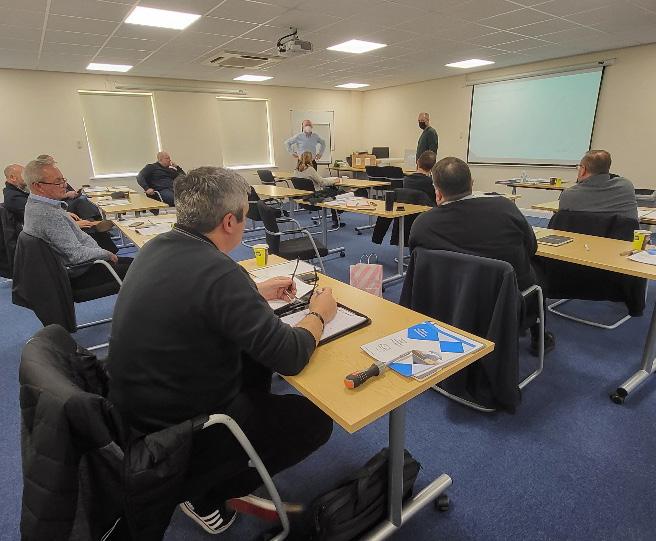



Cornerstone offer an affordable Property Health solution for social housing clients and their tenants – for the long term

Why are we still witnessing mould in properties?
This issue remains with us and, with the Housing Ombudsman’s call for a Uniform Framework to deal effectively with the problem, there has never been a better time to assess current internal processes alongside your chosen contractors to implement a tailored change that delivers proven reasons behind the outbreaks and how repairs can be certified as cost-effective.
How will retrofits and net zero assist our journey?
Retrofits are indeed designed to enhance the performance of a structure in terms of its health, and decarbonisation aims to assess heat loss, reducing the carbon footprint of a dwelling. Such requirements alone place a greater emphasis on accurate property assessments and a joined-up solution for each property style, its location and indeed, orientation before we head indoors. The understanding of insulating a home, its existing air-tightness and ventilation measures are key to upholding the environmental and indeed social benefits of a dwelling.
What is available to social housing landlords?
A track record of independently surveying and recommending root causations for
damp and mould problems in the social housing sector has led Cornerstone to develop a user-friendly and adaptable support framework that can be selected by respective clients in line with their existing knowledge level and organisational goals for dealing with the issue - for the long term.
Training is available, including CPDaccredited damp and mould understanding, from call centre staff to surveyors.
Consultancy is available, such as independent IoT data and retrofit/decarbonisation impact assessments (PAS 2035), which confirm the impact of each improvement is as anticipated.
Surveying can also be used, with independent root cause analysis of reported complex issues.
Application – sharing our knowledge
Cornerstone offer an accessible, detailed APP for residents and landlords with guidance and key support traits when you need it.
Residents can enter their issue and receive likely reasons alongside credible guidance measures in a recognised format. Still having a problem? Submit the query with images and videos to the landlord through the App.
Landlords can enter the same process with advanced reasoning and guidance for in-house resolution.
Plus, landlords who are seeking CPD Damp and Mould Training, Complex Technical Assistance, IoT Sensor Alert meaning and guidance can simply log the assistance and submit to Cornerstone. J

Learn more about the root causes and implement long-term improvements with… Better Decision Making.







Garratt's Damp and Timber Limited are specialists in the diagnosis and treatment of all manner of damp found in homes and commercial properties in London and the surrounding areas
PCA Trained & Certified, CSTDB, CSSW, and CSRT Certified, we've been established for over 20 years and have worked in royal parks and prisons, as well as partnered with Metro, housing associations and Network Rail. Our experience in the public sector is upheld by our commitment to quality work and transparent communication.
Our expertly trained and qualified team have experience in a wide range of skills gained from years of working in the industry and we will oversee every aspect of your treatment, repair, or renovation as it is carried out from start to finish. All work completed is guaranteed and can be underwritten.
If you are looking for an expert and reliable damp company to carry out damp proofing on your property, you can rest assured that Garratt’s Damp and Timber is a partner you can trust

Are damp and mould issues plaguing your property, causing you frustration? Don’t let these problems diminish your living space any longer. At Acres Building Consultants, we specialise in tackling damp and mould head-on, providing comprehensive investigation and testing to provide strategies that will restore and revitalise your property.
Our experienced professionals understand the detrimental effects that damp and mould can have on your home. That’s why we employ the latest techniques, testing and technologies coupled with a wealth of experience to identify the root causes of these issues.
Whether you’re dealing with rising damp, condensation, mould growth, or any other related issue, we have the knowledge and resources to identify the cause.
Don’t let damp and mould dictate the condition of your property any longer. Take control of your indoor environment and transform your space with Acres Building Consultants. Visit our website below to learn more about our damp and mould services and schedule a survey today.







Andrew Devitt, technical manager at the Property Care Association talks about how to respond to a property flooding
For owners of properties that have experienced unprecedented flooding within their homes, there underlies a mixture of emotions prior to the flood, during the flood and after the water has receded. The physical impact of flood water can cause irreparable damage to personal items and will have a devasting and costly impact to the building’s structural integrity and the damage of fittings and building services. Physical recovery from the flood will take several weeks, possibly months but the emotional recovery can take much longer. There are also reported cases of hidden damage caused by the original flood waters not identified initially and later covered over by remedial repairs and later reappearing resulting in further extensive remedial works adding further distress to residents.
Flooding is defined as the covering of normally dry land with a large volume of water and is the consequence of the occurrence of natural weather events. This may be caused by the action of heavy and intensive rainfall over a brief period or prolonged rainfall combined with other factors like saturated ground, high windstorms, or high tides.
The common types of flooding in the UK include:
Coastal flooding – heavy overwater coastal storms combined with offshore rainfall and high tides cause sea levels to significantly rise above normal levels forcing sea water to the land. River flooding – heavy or prolonged rainfall over time on high ground worsened by snow E

F melt waters. This water is directed through tributaries into the lower lying rivers which are incapable of supporting the increased volume of water and the river bursts or overtops its banks and floods the areas around it. This is the most common occurrence of flooding in the UK. River flooding can also occur if the free flow of the river gets blocked by debris in the channel caused by fallen trees, natural overgrowth, or rubbish.
Groundwater flooding - this can occur when water levels underneath the ground rise above normal levels, in effect saturating the top surface and may puddle above the surface itself. It is usually caused by prolonged periods of rainfall. Several hundred thousand properties in the UK are affected by this form of flooding. Combined with surface water flooding, when heavy rain directly hits the ground surface, it can affect vast surface areas as there is nowhere for the water to infiltrate and therefore may last prolonged periods of time.
Flash flooding - is the result of a fast-moving and unexpected flood. Flash flooding is predominately caused by heavy rainfall but, it may also arise from a failure of a flood defence or drainage system. It is expected that the frequency of flash flooding will increase due to climate change and over-development within flood plains.
Sewer flooding – when a sewer system, foul or surface water does not have enough capacity to take in an increased volume of water because of heavy rainfall, river or highway flooding causing blockage.
It is expected that the frequency of flash flooding will increase due to climate change and overdevelopment within flood plains
With worsening global climate conditions, it is predicted that the risk of flooding will increase. Raised sea levels and temperatures will not only increase the amount of water on the land but the volume, frequency and intensity of rain falling over land will also increase.
According to the Environment Agency, there are an estimated 5.2 million homes at risk from flooding. This is a considerable proportion of the UK housing stock. A question arises as to how many of those homeowners are aware of the potential flood risk to their homes? Various environmental agents are reviewing, adjusting and extending potential flood boundaries to the existing flood risk mapping. Planning authorities approving developments adjacent to existing flood risk zones will effectively place these properties now within a flood risk zone. Residents may only know that their homes are at risk after a flood event has occurred.
After the flood waters have dissipated, the time comes when flood resilient repairs are necessary to the property and the supplied services. It is not a question of removing the water damaged materials and replacing them with new ones. It is essential that a detailed investigative assessment of the damage to the structure is required by an experienced and qualified building surveyor who not only understands the evident physical damage to the building structure and fittings but also is aware to the hidden and concealed areas where water may become latent resulting in a structural

Service entry and ventilation points will all need to be addressed to ensure that when it comes to the drying out process all areas are eliminated of free water
defect following completion of the building recovery works.
The surveyor’s assessment must conclude that if a flood event has occurred even just the once it is highly likely that it will reoccur from the same sources and therefore the restoration of the property will need to reflect this in terms of its structural integrity and the specification of water resilient materials to improve its resilience.
Considerations by the surveyor for remedial solutions will include the flow speed of the water. Depth of the flood water and if it carried physical debris. These will all impact on the structural integrity of the building requiring structural maintenance to the external fabric. The local topography building orientation and local drainage will need to be understood to establish if the risk of future structural damage could be lowered. A full understanding of the building construction is required to evaluate potential fabric damage both above and below the ground which include the materials and linings used. Service entry and ventilation points will all need to be addressed to ensure that when it comes to the drying out process all areas are eliminated of free water minimising future potential building defects occurring.
The Construction Industry Research and Information Association (CIRIA) has produced guidance on the code of practice for flood resilience for practitioners which considers the design stages for producing a resilient solution. Furthermore, British Standard Institution BSI are producing a new guide document BS 85500 Flood resilient construction - Improving the flood performance of buildings to be published later this year. The scope of this document is to give recommendations and guidance to improve a building’s resilience consideration of resistance and recoverability to reduce the impact from flooding. The document includes guidance for new buildings as well as the retrofit solutions and is consistent with the CIRIA Code of Practice.

Design resilience implies an approach that comprises some resistance to flooding with an ability to recover quickly and effectively after a flood, and a “build back better” or adaptive design process that incorporates learning from each flood event and this will provide a valuable document as it covers aspects for the characteristics of flooding the hazards materials as well as providing examples for flood resilience in differing building construction.
The Property Care Association (PCA) is the UK’s leading representative organisation for the protection of buildings. Championing high standards of professionalism, providing guidance, expertise, and advice for homeowners and professionals. When we hear that flooding occurs, we understand and appreciate the stresses and anxiety of such a devastating event upon the homeowner. Our skilled and audited membership operating across the domestic, commercial and civil sectors in the structural repair, structural waterproofing, timber preservation, damp protection and flood remediation can provide the full technical support to survey and remediate the damage lessen the impact of a flood reoccurrence. M

Harnessing the power of natural cork, SprayCork wall & roof coatings are an innovative and eco-friendly solution for new build and retrofit buildings.
Cork is one of the world’s most sustainable natural resources with a negative carbon footprint. No trees are felled during its harvest - in fact the bark grows back each time, absorbing much more carbon dioxide than usual, making it a powerful ally against climate change. All elements of the cork is used, from wine stoppers, to building coatings and biomass - making it a zero waste industry.
It is a strong thermal insulator reducing the dependence on heating systems, which also helps eliminate condensation and black spot mould. It helps to improve acoustic comfort, and with extremely low VOCs is one of the safest wall coatings available which helps to improve air quality against airborne particles. Added to this, as it is hypoallegenic it helps to improve air quality against airbourne particles.
Applications:
> Mould reduction in social housing
> Internal & external solution to refurb all property types
> Safe encapsulation of asbestos



SprayCork is a sustainable and eco-friendly sprayed cork coating that can reduce heat loss and prevent mould growth
4-6mm with 2mm skim, which also increases the energy efficiency of the property, providing tenants a healthy and safe space to live, and peace of mind to the landlord.
We know the stats: the housing stock in the UK is amongst the oldest in Europe; approximately 3.5 million occupied homes were not suitable and did not meet the Decent Homes Standard in 2020, with 4 per cent having serious damp issues1; and 32 per cent of category 1 hazards are for excess cold2
And yet, these issues are still affecting the health of tenants living in social housing.
The Social Housing (Regulation) Act 2023 was introduced to give greater legal protection to tenants, including new consumer standards and a regular inspections regime. This includes landlords ensuring that the homes they provide are fit for habitation and are free from serious hazards, including damp and mould.
It is crucial to provide homes that are safe, warm, and dry for everybody.
There are many remedial solutions for excess cold, and damp and mould. Some of these are simply short-term fixes, but there are many innovative and sustainable products that provide long-term solutions. There are often barriers around the specification of these solutions, so building strong relationships is key to using innovation to solve the retrofit problems faced within UK social housing.
SprayCork, from CorkSol UK, is a sustainable and eco-friendly sprayed cork coating for walls and ceilings that can stop penetrating damp and condensation forming on surfaces. It is an extremely thin coating, applied at
Thanks to its application, the spray applied material creates a continuous barrier which eliminates the risk of cold bridging. And as the system improves air tightness, it helps to improve the thermal performance of the property and makes it warmer as more heat is retained within the property.
This makes SprayCork an ideal solution for hard-to-treat properties that suffer from poor energy efficiency, excess heat loss, and black spot mould.
In addition, the thin layer at which the product is applied makes it perfect for: small rooms and tight spaces where thicker layers cause unacceptable reduction in room size; properties with historic internal architectural details, which should not be concealed behind thick layers of insulation for conservation reasons; properties on a tight budget, who do not want the extra cost, time and hassle of repositioning services such as electrical points and radiators. J
FURTHER INFORMATION
www.corksoluk.com
References:
1. https://assets.publishing.service.gov.uk/government/ uploads/system/uploads/attachment_data/file/1088447/ EHS_Housing_quality_and_condition_report_2020.pdf
2. https://files.bregroup.com/research/BRE_Report_ the_cost_of_poor_housing_2021.pdf


Robyn Millen from the Glass and Glazing Federation explains the benefits of good quality windows
Back in 2019, the government revealed their Net Zero Target for 2050, announcing their dedication to cut the UK’s carbon emissions by 80 per cent. Currently in Europe, the homes in the UK rank among the least energy efficient. To achieve these targets, 80 million windows in homes across the country need to be replaced, as they are inefficient and at least 20 years old.
24 per cent of the UK’s carbon emissions come from the residential sector, highlighting the significant contribution of residential activities to the overall carbon footprint in the UK. Carbon emissions from the residential sector mainly result from energy consumption for heating, cooling, and powering appliances in homes, making energy efficiency in residential buildings crucial for reducing carbon emissions and combating climate change.
‘A Window of Opportunity,’ a collaborative report published last year by the Glass and Glazing Federation and British Glass, revealed that windows installed today perform significantly better than older double glazing and single-glazed windows, potentially saving
residents in the UK up to £395 per year off their energy bills.
There are multiple reasons why local authorities and residents should be swapping out old windows with newer, more energy-efficient replacements, such as:
Enhanced insulation
Older windows, particularly those fitted before 2002, often lack sufficient insulation. This means they let heat escape during colder weather and allow warmth to infiltrate your property on hot days. Consequently, occupants end up relying more on heating and cooling systems to keep a comfortable indoor temperature, which results in a higher energy use and causes properties to expel greater carbon emissions.
Decreased energy usage
Upgrading to energy-efficient windows enables tenants to slash their energy consumption for heating and cooling. Thanks to their superior insulation properties, energy-efficient windows
help keep stable indoor temperatures, requiring less energy.
Over time, old windows can develop gaps, cracks, or worn seals, allowing drafts to pass through the home. These drafts lead to energy wastage as heating or cooling systems overwork to compensate for the lost air. Newer, energyefficient windows are thoroughly designed and installed to minimise air leakage and prevent drafts.
The Building Regulations Act 2002 states that any replacement windows installed after 2002 must meet specific energy efficiency standards. They must achieve a minimum energy performance rating of ‘C’ or higher, and doors must be E or above, with exceptions for historic properties and conservation areas.
This is to comply with the Energy Performance Certificate provided by a local authority, such as the British Fenestration Rating Council (BFRC).
What are the benefits for a home?
Upgrading old windows offers multiple benefits for a home, including enhanced comfort and heightened security, making it a wise investment for occupants. Upgraded windows often come with advanced security features, enhancing the safety and protection of the home against intruders.
By replacing the old windows in your home with new double glazing that meets current energy efficiency standards, a home can significantly reduce its energy usage and carbon emissions and as the importance of cutting energy bills and reducing emissions from each homes grow, investing in energy rated windows and doors has never been so important.
New windows can also enhance the overall aesthetic appeal of a home, boosting its curb appeal. Another benefit of replacement windows includes improved sound insulation, provided by modern windows helps create a quieter indoor environment, shielding occupants from external noise pollution.
What is a BFRC rating and why is it helpful?
The BFRC energy rating is an energy balance of positive contributions from solar gain minus the negative factors of thermal heat loss and air leakage, and BFRC rainbow ratings are
New windows can also enhance the overall aesthetic appeal of a home
a consumer-friendly way to prove product performance to homeowners.
Windows are rated using an A++ to E scale to symbolise the total energy efficiency of the windows. The higher the rating the better the performance. Windows and doors with an energy rating from A to A++ are considered to be energy positive.
When you purchase a BFRC rated product, you are making sure the energy efficiency of the whole window or door system you are buying has been independently tested to determine how well it keeps heat in (U-value), the amount of energy available from the sun (G-value), and the amount of air leakage (L-value).
BFRC ratings serve a purpose beyond just compliance with regulations; they help you in selecting the right energy performance to enhance the comfort of your home. By fitting BFRC rated energy efficient windows and doors, they can assist you in reducing your energy bills.
Adhering to energy efficiency standards and utilising energy rating councils like BFRC ensures informed decision-making, promotes sustainability and reduces environmental impact. As energy prices escalate and the importance of reducing carbon emissions grows, the case for investing in energy-rated windows and doors becomes increasingly compelling. By embracing window replacement, homeowners not only enhance the performance and aesthetics of their homes but also contribute to a greener, more sustainable future for all.
The imperative to replace old windows with energy-efficient alternatives cannot be overstated. With the UK government’s ambitious Net Zero Target for 2050 and the pressing need to reduce carbon emissions, upgrading windows in homes across the UK is a pivotal step towards achieving energy efficiency in households.
In summary, replacing old windows offers a range of benefits, including improved energy efficiency, enhanced comfort, increased property value, better sound insulation, and enhanced security. Replacement windows are a practical and effective way for residents to enhance the overall quality and performance of their homes while enjoying long-term cost savings. L
The market leading solution for digitally managing Fire Door Compliance inline with Regulation 10 and BS 8644-1 2022.




FireDNA is the Building Owners and Facility Managers first choice for digitally managing Fire Doors and Doorset assets. Developed in collaboration with Passive Fire Product Manufacturers, Installation Contractors and Qualified Fire Door Inspectors, the FireDNA benefits are numerous and extensive and include the following:
• Facilitates the Golden Thread of information
• Helps to enforce regulatory compliance
• Supports BS 8644-1 2022 ‘digital management’
• Enables accurate auditing and reporting
• Builds an accessible ‘digital’ O&M Manual
• Delivers critical data at the time of need
• Creates substantial time and cost savings

Email:

Cladding system fires have been increasing globally, with the UK reporting the third most casualties per population since 1990. Combustible cladding systems are approved on high-rise buildings in the UK by the performance-based route to compliance, using the BS 8414 test method and BR 135 assessment criteria. This test involves installing a representative cladding system on a 10 m high test rig and subjecting it to a large fire representing a room in flashover venting out a window and attacking the front face of the cladding system. However, serious questions have been raised regarding the appropriateness of the fuel source, test construction, construction detailing, assessment criteria, and availability of test results.
The FPA, through RISCAuthority, conducted a research project with the aim of enhancing the safety of tall buildings by preventing fire spread through external cladding systems. The project culminated in the development of RISC 501, a ‘fire safety assessment test for external cladding systems’. It is a large-scale fire test method and assessment method that is designed to be
conducted alongside BS 8414 so that the results can confer compliance with both BR 135 and RISC 501.
A database was populated with data from various fire tests of external cladding systems conducted according to the BS 8414 test method and evaluated against the BR 135 performance criteria, with the results compared to the fire performance of cladding systems in the real world. The primary objective was to generate data that would serve as a foundation for critically evaluating the BS 8414 test methodology by exploring the strategies and interpretations employed to meet the BR 135 criteria.
The analysis identified several irregularities with the construction detailing between real buildings and the representative test setups. Unsurprisingly, all of these irregularities resulted in the test setup being better E
Fireco offers a range of compliant hold-open devices for fire doors, suitable for any environment, with Site Manager remote monitoring.


Freedor Pro takes the weight out of heavy fire doors, allowing you to keep them placed open easily with its free-swing feature. Activated via radio signal to close all doors, it prevents the spread of smoke and fire.
Expandable system: add new Pro units anytime.
Improves access for those with mobility issues
Ideal for all areas, like corridors, kitchens and stairs


DorMag Pro is a wireless fire door magnet that holds fire doors open legally, auto-disengaging on alarm. As it’s radioactivated, it’s ideal for noisy environments.
Activates to fire and fault as part of a critical system
View live status with remote monitoring software
Durable device with flexible fitting options
Freedor Pro DorMag Pro
F protected from fire ingress and fire spread than the real buildings. During fire tests, the edges of the test rig would be sealed, preventing the natural ventilation seen on real buildings. This reduces the oxygen available for combustion and can have a significant impact on the growth of the fire. There is a burn chamber at the bottom of the test rig, where the fuel load for the fire test is placed. The burn chamber opening was often overprotected using materials and methods that were not repeated on real buildings. This overprotection prevents fire from entering any cavities behind the cladding system and attacking the combustible insulation in a way that fire normally would through weaknesses like windows. The most severe form of overprotection came from the overuse of cavity barriers. Most systems contain cavity barriers and fire breaks to prevent fire spread through cladding systems and comply with Approved Document B. ‘Clever’ interpretation of the test rig allowed for the use of five horizontal cavity barriers per test, when only two or three would be used over the same space on a real building. This will undoubtedly have a significant impact on the performance of the cladding system during a fire test.
The BR 135 performance criteria specifies a maximum temperature limit that must be
It has often been argued that 500°C would be a more appropriate limit for judging the combustion of typical cladding materials
met during the first 15 minutes of the fire test. The number of combustible insulation products which would survive this 15-minute period before rapidly developing into a fully involved cladding fire is astounding. This gave the impression that they had been chemically engineered to last 15 minutes but no longer.
The scientific justification for this 15-minute assessment period has never been fully revealed and neither has the temperature limit, which is just over 600°C. It has often been argued that 500°C would be a more appropriate limit for judging the combustion of typical cladding materials.
Even if this assessment of a rate of fire spread of 15 minutes per floor had some relevance to life safety, it clearly has no relevance to property protection. There are many cladding systems on the market that are capable of preventing fire spread to multiple floors and there is no reason why this shouldn’t be the minimum requirement.
RISC 501 was developed to specify a test method and assessment criteria for the fire performance of external cladding systems and was designed to be conducted concurrently with BS 8414.
Some notable feature differences of RISC 501 include: additional design requirements affecting floor heights and cavity barrier locations; additional design requirements affecting detailing around the burn chamber opening and edges of the test rig; different sensor locations; different sensor criteria; additional gas sampling requirements; additional mechanical performance requirements; and additional material characterisation requirements.
The test construction criteria now mandate that all systems must design against the same virtual building. The virtual building is not actually constructed on the test rig but exists to specify locations for floor heights and window E
It is regularly reported that fallen material has impeded firefighting operations
F openings. This ensures that all cladding systems tested are designed against the same building, allowing results to be comparable whilst preventing systems from being overprotected from fire spread by designing against an unrealistic building.
An impact assessment was conducted to identify the impactof lowering the temperature criteria and extending the measurement period. It was noted that with the current temperature sensor locations, many non-combustible systems would fail to meet stricter requirements (due to flame spread in the cavity). This suggests that the test would be too onerous with unrealistic performance requirements. This was partly due to the close proximity between the temperature sensors and the flames from the burn chamber. The temperature sensors were, therefore, moved further away from the fire, allowing the temperature criteria to be lowered and the measurement period to be extended to the full duration of the test.
The virtual building also specified a floor height between the peak flame temperature and the temperature sensor locations. This meant that a typical cladding system would place a cavity barrier between the test fire and the temperature sensors, allowing for an

assessment of the cladding systems’ ability to prevent fire spread to multiple floors.
During real cladding fires, it is regularly reported that fallen material has impeded firefighting operations, which will clearly have an impact on both life safety and property protection. Mechanical performance criteria were therefore set based on the performance requirements for firefighting helmets.
Smoke toxicity is an emerging issue across the entire fire industry, so criteria were set for extracting and measuring gases from the rear of the cladding system. No performance criteria were set, as further research is required on the relationship between the concentration of toxic products produced by a cladding system and the potential concentration of toxic products in an adjacent room inside the building.
Products can differ between fire tests and realworld applications for a variety of reasons. Continuous improvement: products are constantly being changed and improved to keep up with changes in the market. Minor changes do not constitute the need for re-evaluation of fire ratings. However, cumulative alterations can eventually amass into significant changes. Although significant changes should prompt retesting, this step is not necessarily conducted. Test specials: manufacturers could employ chemically enhanced products to deceive a fire test house. These enhanced products might be too expensive to mass produce, leading to cheaper, worse-performing products sold to market.
Insufficient test specification: the test standard might lack precise specifications, allowing a product used in a fire test to differ substantially from the real-world application, while still complying with the defined parameters.
To address the potential issue of manufacturers using superior performing products in fire tests, compared to those actually installed on buildings, a method for material characterisation was developed. This method produces a representative ‘chemical fingerprint’ of the products tested using small scale tests designed to identify significant chemical variations between products submitted for testing and those supplied to market. This method employs microscale combustion calorimetry and infrared spectroscopy to establish a unique chemical

fingerprint for each major component of a cladding system.
This approach was found to be capable of identifying new chemical substances, detect the absence of existing ones, assess changes in combustion properties, and quantify process reactions, such as the formation of isocyanurate rings.
Validation tests were conducted against the proposed RISC 501 method to compare the results of the predicted performance of cladding systems during the test, to their actual performance, with the aim of identifying: any physical impossibilities with the implementation of the prescribed test setup, including construction detailing and sensor locations; the test’s ability to identify flame spread through known combustible cladding systems; the test’s ability to identify a lack of flame spread through known non-combustible cladding systems; the test’s ability to identify mechanical failures; and the test’s ability to measure a significant difference in the smoke toxicity between a combustible and noncombustible system.
Ultimately, RISC 501 was found to clearly differentiate between systems which promoted fire spread and systems which did not. It offers a much clearer distinction than the BR 135 assessments, whilst also using stricter performance criteria.
In summary, RISCAuthority conducted a study to investigate critical issues related to cladding system fires and the fire testing of external cladding systems, particularly in the UK, where combustible cladding systems are approved
Ultimately, RISC 501 was found to clearly differentiate between systems which promoted fire spread and systems which did not
for high-rise buildings. The findings from that research were used to develop the fire test and assessment method: known as RISC 501 – Fire Safety Assessment Test for External Cladding systems.
This article only covers some of the main changes, but there are a significant number of other changes mandated based on the extensive research project. The research behind this work will be shared with the British Standards Institute and the European Commission so that the findings can also aid the development of future British and European cladding test standards. M
About the Author: George Edwardes, technical director at the FPA George is responsible for collaborating with stakeholders, and directing policy development and quality assurance. He also manages the Technical Steering Group, comprising the FPA’s technical experts. George holds a BEng (Hons) in Mechanical Engineering and is currently conducting an MSc by Research, focusing on fire safety assessment tests for external cladding systems.
The test and assessment method is freely available to download from the FPA website: thefpa.co.uk/fire-testing









The Amenity Forum explains why it’s important to have a strong grounds care policy and schedule
Vegetation control plays a significant part in maintaining public spaces. Historically when there were residual herbicides to employ, local authorities would often use their own staff to apply these during the winter months prior to the seasonal tasks of mowing and maintaining open spaces.
In the light of weed control becoming a task that requires multiple applications of nonresidual herbicide, these applications now need to be carried out during the growing season. For the public sector, now more than ever, there is a great need to ensure that procurement
processes deliver amenity contractors that are qualified, experienced, and fully compliant. Whilst in recent years the scoring matrices for such contracts have shifted towards quality rather that price, the advent of the Official Controls (Plant Protection Products) Regulations 2020 have elevated the need to secure compliant suppliers.
One of the primary objectives of the Official Controls Regulations (OCR) is to ensure that Plant Protection Products (PPPs) are used E

F sustainably and in accordance with the conditions of use. There is a legal requirement for the following groups to register.
1. Businesses that produce, manufacture, process, import, store, distribute and sell PPPs, their components and adjuvants to be used with PPPs are subject to the 2020 regulations.
2. Any person or business that uses PPPs and any adjuvants in a professional capacity in Great Britain (England, Scotland and Wales) are also subject to the 2020 Regulations, and therefore have a legal obligation to register.
3. Sellers of amateur PPPs are also subject to the 2020 Regulations and need to register by 22 June 2022. Amateur PPPs are not intended for professional use and amateur users do not need professional certification to apply them.
Amenity users are those who do professional work in gardening, landscaping or grounds maintenance or another role in an amenity setting such as in: schools; parks; sports grounds, including golf courses; public or private property; infrastructure, such as roads, railways and waterways; utilities, such as transport and water companies.

Safeguarding the future of PPPs is recognised as being critical to ensure that we can maintain our amenity spaces


Inspection visits have commenced, and enforcement officers are visiting both those that have registered, as well as businesses that should have done so before now. PPP stores, application equipment and record keeping are all under scrutiny and those organisations that have non-compliance will be visible on the HSE website.
The Amenity Forum has fully supported the introduction of the OCR regulations, as safeguarding the future of PPPs is recognised as being critical to ensure that we can maintain our amenity spaces efficiently in the future. It is of course important to make clear that as a sector, the ongoing employment of sustainable practice is key to a well-maintained urban environment.
PPPs form only a part of the picture, as integrated management starts long before the need to apply such products. The design of our amenity spaces plays a huge role in facilitating the maintenance thereafter, avoiding areas that trap detritus, creating hard surfaces with contours that can be swept and choosing well suited materials all play a big part. When however, weeds present, PPPs of course are tremendously useful in restoring the clean environment that we all want to see.
Invasive plant control is another task that needs to be considered carefully. Given the high environmental and financial cost of mismanaging the likes of Japanese knotweed, it is
A visit to the Amenity Forum website should prove to be a useful resource when looking to author procurement documents
crucial that programmes are well planned and competently implemented.
So, the importance of selecting the right contractor to deliver these services is clear.
A visit to the Amenity Forum website should prove to be a useful resource when looking to author procurement documents. Members of the forum (a growing number of whom are local authorities) have access to a wealth of knowledge and advice. Currently there are updating days taking place in various locations where those attending can learn about legislative change, OCR inspection rollout as well as feedback their views and experience to help to inform future policymaking.
As we anticipate the publication of the new National Action Plan for the Sustainable use of Pesticides (NAP) there has never been a more important time to ensure that the public sector engages with the highest quality contractors to achieve its aims. M
https://amenityforum.co.uk/


The importance of 3M Bright Screen Laptop Privacy Filters for government and public sector users
Data security is crucial in today’s digital age, particularly for government and public sector organisations. Protecting on-screen data is essential, and this article emphasises the importance of 3M Bright Screen Laptop Privacy Filters in enhancing data security for laptop users in these sectors.
Laptop screens are vulnerable to visual hacking, where unauthorised individuals can view or capture sensitive information. This poses a significant risk, especially in public spaces or shared work environments.
3M Bright Screen Laptop Privacy Filters address this vulnerability by limiting the viewing angle, ensuring that only the user can see the screen contents. This protects sensitive information in crowded or open environments.
Government and public sector employees often work in public spaces where visual hacking is common. These filters act as a shield, preventing prying eyes from accessing sensitive data, ensuring privacy and maintaining data integrity.
Shoulder surfing, another technique used by hackers, is effectively mitigated by these filters. By reducing the viewing angle, it becomes nearly impossible for shoulder surfers to gather valuable information, enhancing data security.
Compliance with data protection regulations is crucial. Implementing 3M Bright Screen Laptop Privacy Filters
demonstrates an organisation’s commitment to data security and compliance, protecting sensitive information at all times.
With the rise of remote work, data security is even more critical. These filters provide an additional layer of security, allowing employees to work confidently in public spaces without compromising data confidentiality.
Investing in these filters is cost-effective compared to the potential consequences of a data breach. They are easy to install, durable, and compatible with various laptop models. By implementing them, organisations can significantly reduce the risk of visual hacking and protect their valuable data assets.
In conclusion, data security is a top priority for government and public sector organisations. 3M Bright Screen Laptop Privacy Filters offer an effective solution to safeguard sensitive information, maintain data confidentiality, and comply with regulations. Investing in these filters enhances data security and ensures the privacy of on-screen data, even in challenging environments. M


Nigel Wilcock, executive director of the IED argues for more statutory powers for councils when it comes to economic development

Since 2018, eight English local authorities have issued Section 114 notices which indicate that the council’s forecast income is insufficient to meet its forecast expenditure for the next year, as the sector’s coffers reach breaking point.
More worrying, but not surprising, is almost one in five council leaders and chief executives in England surveyed by the Local Government Association (LGA) last year think that it is very or fairly likely that their chief finance officer will need to issue such a notice this year or next due to a lack of funding to keep key services running.
The magnitude of this issue, most notably at Birmingham City Council, has made frontpage news. In fact, four councils in the past 12 months have declared themselves in effect bankrupt, while more have signalled drastic spending cuts as they attempt to avoid potential insolvency.
Now, this is attracting political attention at the highest level, including through the Levelling Up, Housing and Communities Committee report on financial distress in local authorities, published in February. In this report, the crossparty committee said that ministers must urgently inject £4 billion into English town hall budgets to head off an “out of control” financial crisis that threatens to drag well-run councils into bankruptcy and put local services at risk.
For now, following the initial Local Government Financial Settlement, councils in England have been handed an extra £600 million in funding to tackle the worsening financial crises, with £500 million available for social care, alongside a further £100 million in other funding guarantees and grants. Taking into account this new funding, levelling up secretary Michael Gove reported that the top-up in the financial package for English councils meant an overall increase in their budgets of up to £4.5 billion next year.
Whilst the LGA has said that it will “continue to work with Government to achieve a sustainable long-term funding settlement and updated distribution mechanisms, as well as legislative reform where needed, so that local government can play its full part in delivering inclusive prosperity and growth through investment to support people, places, and the planet”, we need to think bigger about our collective approach to council income-generation activity. This, in turn, links directly to the biggest issue facing this country.
Sustainable economic growth is urgently required to help deliver the funding for government to tackle significant areas of under-investment. With an aging population, this will require significant improvements in productivity but at present, the UK economy is flatlining and the high inflation of 2022 and 2023 has impacted on living standards and consumer expenditure. Serious questions are now being asked about current approaches to stimulating growth.
The nationally-led approach to stimulating growth has under-delivered for decades, and the National Audit Office found that since 1975, successive governments have introduced more than 55 separate policies targeting economic growth in England, with £18 billion being spent between 2011 and 2020 alone. Put simply, this is not working, and it is time to enable effective action to drive economic growth that is locally led.
With the Government transferring Local Enterprise Partnerships (LEPs) to local government, the pivotal economic role of councils for realising the country’s growth ambitions has been articulated. This is why the Institute of Economic Development (IED) has recently launched its Grow Local, Grow National manifesto for change calling for councils to be given statutory powers over economic development so they can help create highquality jobs, attract investment into local areas, and turbocharge the UK plc. E


F Giving local authorities a legal duty over economic development would create a clear accountability structure, which in turn would make it simpler and more attractive to UK and international firms and financial institutions to invest in places. It would also enable the development of local strategic economic development plans that respond to the views of local businesses, as well as the wider community.
Enhanced local focus on tackling stagnant growth and inequalities, in particular through resources invested in regeneration and boosting residents’ skills, would be facilitated and council staff upskilled with the tools and knowledge to help drive real economic growth. With the right level of resources, councils can stimulate growth across the country, addressing the social, regional and financial inequalities that exist between places, delivering the productivity our economy so desperately needs.
Economic development’s role in understanding the drivers of growth and the needs of communities is clear, but the detailed work required to create positive change requires local understanding.
Without recognition as a statutory function, the importance of economic development
A strong economic development function can also ensure government priorities in areas such as levelling up are developed more effectively at the local level
can be under-prioritised as difficult funding decisions are made, although in the medium term a solid economic development strategy can create the foundations on which local areas can improve financial performance. A strong economic development function can also ensure government priorities in areas such as levelling up are developed more effectively at the local level.
The IED believes that it is only through this approach that national policies can be consistently implemented at a local level –and that economic development can make a difference to residents of areas at the local level. Alongside this overarching call to action are a series of recommendations (read our full manifesto for the detailed asks) sitting within six supporting pillars which we deem critical for success.
As increasing local devolution moves up the political agenda, it will be essential for local authorities to have in place the models to ensure that local evidence can be gained, effective policies developed and implementation delivered.
Underpinning all economic development and associated projects is a requirement for a more stable and long-term funding landscape.
3. Net zero
The IED fully supports the mission of the Blueprint Coalition’s Manifesto for Local Climate Action, a core part to this being recognition of the need for a place-based approach to tackle climate change and move towards net zero.
Growing our businesses, attracting investment into our local areas and supporting exports is a fundamental part of any locality’s economic development remit, helping to increase pay, employment and productivity.
A statutory economic development function would be involved in assessing local skills, key sectors and provide skills intelligence for local skills providers, employers and the workforce. Skills development, workforce assessment and the development of clear pathways into work would be a key element of the economic strategy.
Legal duty for economic development remit would need to be underpinned by an experienced and stable workforce. Underinvestment in economic development and funding settlements for local authorities has meant important economic development skills have been lost to the profession and there is a need to rebuild them.
It is no surprise that both the government and opposition parties have made growing the economy a key focus for the forthcoming general election.
With a stagnating economy, and as increasing local devolution moves up the political agenda, it is essential for local areas to have in place the economic development models to ensure local evidence can be gained, effective policies developed and implementation delivered. This is the core role of any economic development function and it seems unthinkable that despite moves towards devolution, economic development is not one of those areas deemed as a statutory responsibility of each local authority.
Councils could deliver so much more if they were given statutory powers
Statutory powers for councils
Councils could deliver so much more if they were given statutory powers, with their unique understanding of local economies, to better ensure policies are adapted to local conditions and make the most of the strengths of local places.
Having discussed our manifesto with key decision-makers, and with more Westminster meetings held or scheduled, we welcome further engagement with all parties to improve decisions on economic and industrial strategy development, leveraging the unique experience the economic development profession has of delivery.
We call on all parties to recognise the critically important role that economic development practitioners have in delivering levelling up and place-based economic transformation. M
Nigel Wilcock is Executive Director of the IED. The IED Annual Conference and Awards Dinner 2024 is open for early bird registrations.

A read of any council’s Medium Term Financial Strategy (MTFS) document will reveal the drive to digital as a core focus. ‘Digital transformation’ is a commonly used phrase within the private and public sector, but what does it really mean to local government and other public sector organisations? Gerry Crawley from Adare SEC lifts the lid on this ubiquitous term
Is ‘digital transformation’ a confusing term for the sector?
In very simple terms, digital transformation can be summarised as “the adoption of digital technologies to improve processes, reduce costs, manage risk and deliver an improved citizen experience”.
The word transformation is not especially helpful. It suggests the necessity for sweeping and total change. The truth is that transformation can occur gradually, in small steps, with each ‘win’ providing the proof-point to convince decision-makers within organisations to green-light further digital plans.
Some councils and public sector bodies are more advanced along the digital transformation path than others. But every public sector organisation will recognise the operational and efficiency challenges presented by inflexible and outdated processes that are heavily reliant on manual intervention.
The sector is really facing a perfect storm of challenges. Budgetary pressures are severe at a time when citizen expectations in terms of service and interaction have never been higher. Add to this the complication of hybrid working and dispersed teams and it quickly becomes clear that legacy processes are poorly equipped to cope.
Digital transformation can present citizens with choice over how to respond or sign-up or complain, easing the burden on internal teams and expediting vital functions such as payments and collections. Digital transformation is also empowering today’s hybrid working world, enabling authorised remote workers to edit and share and issue documents from wherever they’re working.
The bigger picture is greater efficiency and cost-savings through the reduction of manual, paper-based processes.

What do ‘small steps’ look like? Where might organisations realise immediate wins?
Adare SEC works with organisations to understand current processes and identify obvious and achievable pathways to digital progress. This is not about simply transferring existing paperbased services onto a computer screen - a broken process is a broken process. It’s about designing new and better approaches that place internal efficiencies and citizen outcomes at the core.
One recent example involved digitising incoming mail for a housing association. Previously, this work had been done by one person in a mailroom using a multi-functional device, with the resulting scanned documents then emailed onwards for continued processing. This was clearly a hugely time-consuming process with no reliable audit trail. Today, all mail is routed to Adare SEC for high volume scanning and is then auto-routed to the intended recipient. Digitised mail is ingested into a web-based portal, offering secure access for authenticated users to view inbound mail from anywhere - whether onsite or remotely. The portal effectively provides a real-time overview of a customer’s entire communication history.
The basic premise of this transformation is not particularly complex. But the efficiency and security gains for the organisation concerned are significant.
How does digital transformation dovetail with the sector’s sustainability agenda?
There is a clear disconnect within the sector between the legacy onsite print production model and stated environmental ambitions. Onsite print happens in two ways - via a network of tens or even hundreds of departmental desktop devices and, in several organisations, via a dedicated in-house print room stocked with equipment capable of higher print speeds and volumes.
This set-up is power-hungry and inefficient in terms of sustainable use of floor-space, not to mention the impact of deliveries to and from the site.
Use of transformation solutions such as hybrid mail enables this bulk print to be directed for processing off premises via a high-volume, highly efficient operations centre. Messages can be printed and posted or sent via text or email to recipients. Whole fleets of in-house, power-hungry departmental multi-function devices can be eliminated and replaced with off premises, multi-channel hybrid mail efficiency.
 Crawley, strategy director, public sector, Adare SEC
Crawley, strategy director, public sector, Adare SEC
Gerry has over 25 years’ experience working with public sector clients to drive down costs and increase operational efficiency. Gerry and the public sector team work with over 100 UK councils and numerous public sector bodies, saving these organisations millions of pounds through the implementation of efficient, multi-channel strategies for highly secure communications.
How is Adare SEC able to assist with public sector digital transformation ambitions?
We work with over 100 councils in the UK along with a host of other sector organisations, helping to drive greater efficiency and choice within citizen communication strategies. We have an expert team coupled with a suite of transformation tools, meaning digital opportunities can be identified, scoped and implemented in as little as eight weeks. This is what we mean by ‘small steps’ – change can happen quickly, without disruption, leading to significant operational efficiencies and bottom-line savings. M



Richard Newman, OBL corporate affairs director sets out some of the key opportunities and use cases for open banking payments and data across the public sector
Open banking is a simple, secure way to help consumers and businesses move and manage their money. Although it has been in use since 2018, the past two years has seen use expand dramatically, and it now counts more than 9.5 million active users in the UK.
It enables two different types of services: a secure way to make payments (through Payment Initiation Services (PIS)); and the ability to set up secure data connections (via Account Initiation Services (AIS)), securely sharing data from an individual’s or firm’s
bank account, such as a balance or transaction history, with FCA authorised or registered providers.
It’s built on the same secure systems used by banks and building societies and uses secure Application Programming Interfaces (APIs) to connect to the user’s bank account.
Providers are normally regulated by the Financial Conduct Authority (FCA) and must follow strict rules to keep data secure. It’s an E
ID checks in seconds, verified and auto-populated direct debit mandates, document-free processes, stronger fraud protection – meet OneID®, the only government-certified open banking identity service provider on the Crown Commercial Services’ Open Banking Dynamic Purchasing System.

With public finances squeezed, public bodies are under under pressure to reduce the cost to serve and decrease fraud as they transact with citizens.
OneID® can help. As the UK’s leading document-free digital identity service provider that uses bank data, OneID® delivers a truly digital and frictionless journey that can be completed in seconds from any device.
USE ONEID® FOR:
Faster pre-employment screening–Cut ID check time for Disclosure and Barring Service (DBS) from days to seconds.
Verify and auto-populate direct debit mandates–Reduce the errors, effort, and time required to manually type and set up direct debit mandates for services like council tax.
Reduce payment fraud–Ensure payments go to the rightful beneficiaries by setting up their accounts with verified and auto-populated bank details.
Digitise and ease the access to local services–Speed up the process of applying for parking permits, alcohol licences and more.

WITH ONEID® PUBLIC BODIES GET:
A secure and government-certified service that’s also regulated by the FCA.
The easiest and most frictionless process that can be completed from any device, anywhere.
Savings and efficiencies from eliminating manual document verification and errors
Widest reach with the ability to verify 50 million UK adults that bank online – including people without a passport or a driver’s license.




F increasingly popular way to pay bills or for goods (particularly big-ticket purchases such as a car) or bills (such as tax or utilities), or access personalised financial products and services, such as budgeting or savings apps, and tailored loans. Many people will have already used open banking without realising it.
It has proved particularly useful to the UK’s 5.6 million small businesses, many of which use it in tandem with their cloud accounts software. Connecting their business bank data to their accounts software enables business owners and finance professionals to get a near realtime snapshot of their finances. This can help streamline cash flow, support forecasting, and help credit applications.
It’s now possible to pay more than 40 different types of tax and duty via open banking
Open banking also enables organisations of all sizes an alternative way to make and receive account-to-account (A2A) payments – to other businesses or customers – that can be more cost-effective than some card payments. As payments are usually made in near real-time, it can also speed up settlement times compared to some other payment types, and ease the challenge of late payments, a common problem for many public sector organisations.
In this article, we explore some of the key opportunities and use cases for open banking payments and data across the public sector.
The UK is a world leader in open banking, and His Majesty’s Revenue and Customs (HMRC) was the world’s first tax authority to offer open banking as a way to pay tax. HMRC launched the service back in 2021, in conjunction with fintech firm Ecospend-Trustly.
The benefits are manifold. The ‘Pay By Bank Account’ option uses HMRC validated and pre-populated payment details, enabling selfassessment taxpayers to make payments direct from their bank account. This speeds up receipt of funds compared to cards and significantly reduces the risk of manual error. There are E

F virtually no ‘suspense accounts’, where funds are unable to be allocated because of a mismatch in unique payment references, supporting cost and time savings, along with administrative efficiencies.
Importantly for the public purse, the cost of an open banking payment is less than taking a card payment. It’s now possible to pay more than 40 different types of tax and duty via open banking, including PAYE, corporation tax, and VAT, and it’s now the third most popular way for individuals and businesses to pay their taxes, after bank transfers and Direct Debit. In January 2024, HMRC collected £3.5 billion of tax payments via open banking, an increase of 16 per cent from the previous year, and the value of transactions was 38.9 per cent higher.
HMRC is currently developing a set of payment APIs which will enable taxpayers to make payments from third party platforms such as mobile banking apps. The plan is also to include a summary of agreed future tax liabilities, allowing individuals and businesses to plan for payments.
The government is also exploring how GOV.UK Pay – currently used across the public sector, from the NHS to police forces and the Ministry of Justice – could offer open banking as a payment option, giving people the option to pay for services via their banking app.
Open banking also has a part to play in supporting rent collection for local authorities, housing associations and educational institutions. Offering open banking as a payment option enables cost savings on card processing fees, as well as reduced operational expenditure and time spent on administration. As with tax collection, reconciliation rates are improved by linking a payment with a unique identifier, reducing manual errors.
Open banking payments can also help tackle rent arrears, a significant problem for local authorities and housing associations. Near real-time payment collections remove the delay in funds clearing, compared with some other payment methods, reducing the risk of arrears. By receiving payments in near real-time, organisations can also benefit from improved cashflow.
Rent and deposit refunds and rebates can also be repaid quickly and securely via open banking.

Several firms in the open banking ecosystem have already been accepted on to the DPS
A new service, launched by the Crown Commercial Service (CCS), the department that supports the public sector in delivering commercial value when procuring common goods and services, offers further opportunities for further cost savings.
Its Open Banking Dynamic Purchasing System (DPS) operates as a ‘vehicle’ for central government and the public sector to source open banking services, helping to reduce the cost of receiving money into public sector organisations.
By reducing the fees incurred by traditional debit card payments, it’s estimated that the DPS could help achieve savings of 70-80 per cent. The services will also help reduce the volume of fraudulent or in-error payments made throughout the public sector.
Several firms in the open banking ecosystem have already been accepted on to the DPS, which means they are eligible to bid for AIS and
PIS Request for Tenders issued by any UK public sector body that uses it. These include central government departments and public sector bodies, such as local authorities, education institutions, not-for-profit and charitable organisations.
Firms listed on the DPS so far include Ecospend-Trustly, GoCardless, MoneyHub, NatWest Bank, OneID, and Ordo (the Smarter Request Company).
Local authorities often work closely with debt charities to refer residents for support and advice in managing their finances. Using open banking data connections to assess an individual’s finances can give debt advisers an up-to-date picture of a client’s finances and help with signposting them to relevant professional advisory services.
In 2023, Citizen’s Advice Stevenage worked with PayPoint on a pilot project using PayPoint’s Financial Information System (FIS) Customer Support Tool. Clients complete a simple online consent form that enables debt advisers to quickly access a consolidated view of their incoming and outgoing funds within minutes, and provide actionable advice.
This is far quicker than the equivalent manual assessment, which can be time-consuming and stressful for both clients and advisers. It also enables advisers to provide support faster, reducing the risk of debts increasing
It’s clear that open banking has delivered cost savings and operational efficiencies across a wide range of public sector organisations
or becoming more serious throughout the consultation process.
It’s clear that open banking has delivered cost savings and operational efficiencies across a wide range of public sector organisations and that there are myriad opportunities to expand these.
Last autumn, the Chancellor announced a ‘ Smart Data Big Bang’, a major expansion of data sharing schemes extending the benefits delivered by open banking data to key l economic sectors. These include energy (utilities and fuel), banking, finance, retail, transport, home buying and telecoms. These will deliver competition and innovation in these sectors, which in turn, will deliver further economic growth and cost savings to consumers, businesses, and, of course, the public sector. J
www.openbanking.org.uk/about-us/








SafeGuarden uses Digital ID and Open Banking for safe data sharing in the voluntary and care sector


In the heart of Spinners Mill in Leigh, Greater Manchester, Verve Community CIC identified a significant gap in the voluntary and care sector. Although organisations prioritise safeguarding children and vulnerable adults, individual volunteers can remain vulnerable. From this insight, the concept of SafeGuarden Volunteers was born.
The Spinners Mill houses over sixty nonprofit organisations and social enterprises. The volunteers are from diverse professional backgrounds, including the NHS, police forces, education, and our armed forces. They are kind-hearted people who, from lived experience, offer a wealth of knowledge in care. They want to make a difference.
Verve provides recruitment services to organisations at Spinners as well as recruiting foster carers and finding employment and training for Armed Forces veterans. All involved welcome that accurate DBS checks, based on job duties, are necessary to protect those in their care as well as safeguard against allegations. However, many express frustrations with repeated form filling or discomfort with technology due to concerns about data privacy.
Verve offers DBS/RTW checks using Spotlite from CDD Services. Together they have created a respectful, safe, and private setting at their Spinners Tea Room to gain empathy and build trust with volunteers using digital technology. The experience is affirming.


Verve’s success is built on the fact that many VCS organisations by their very nature, run on a shoestring with limited resources. It is not uncommon for such organisations to share personal data by email or WhatsApp as they lack the skills and the tools to avoid data loss and potential data breaches. This not only heavily impacts the recruitment success rate, it also places the volunteer in a vulnerable position. Both the VCS organisations and the people who volunteer deserve better! This insight generated the idea for SafeGuarden Volunteers.
SafeGuarden, powered by Spotlite, ensures safe data sharing within the Voluntary and Care Sector. It enables a volunteer to provide their information to multiple organisations, including monthly updates on their DBS and DVLA status. When the volunteer wants to share information with a new VCS organisation, they can do so under their control. No more emails or WhatsApp messages. The VCS organisation receives the monthly updates so both they and the volunteers are protected and reassured throughout the volunteer’s career. Simple, safe, secure.
SafeGuarden is helping communities work together — one volunteer at a time. M FURTHER

In April, the government updated the guidance on how certified digital identity service providers can become certified to complete digital identity checks for schemes like the Right to Work, Right to Rent, and DBS
At the end of 2021, the government announced its intention to enable employers and landlords to use certified digital identity service providers (IDSPs) to carry out identity checks on their behalf for many who cannot use the Home Office online services, including British and Irish citizens.
As well as this, the Disclosure and Barring Service’s (DBS) proposal will enable digital identity checking within their criminal record checking process using certified IDSPs.
In April this year, however, the guidance was updated on how IDSPs can become certified to complete digital identity checks for schemes like the Right to Work, Right to Rent, and DBS. They would be certified in line with the Department for Digital, Culture, Media and Sport’s (DCMS) UK Digital Identity and Attributes Trust Framework.
It is a set of rules organisations agree to follow to conduct secure, trustworthy identity or attribute checks.
This new guidance meant a variety of things for both employers and landlords.
It meant they were able to work with IDSPs to utilise Identification Document Validation Technology (IDVT) to carry out digital identity checks on behalf of British and Irish citizens who hold a valid passport. This includes Irish passports.
The relevant changes to legislation took effect from 6 April 2022.
Enabling the use of IDVT for Right to Work, Right to Rent and DBS checks helped to support long-term post pandemic working practices, accelerate the recruitment and onboarding process, improve employee mobility and enhance the security and integrity of the checks.
This supports the continued development of the DCMS trust framework and enables employers and landlords to make use of IDVT where they already have an established commercial relationship with an IDSP.
To become certified against the schemes, IDSPs must meet the criteria in the current version of the trust framework
Whilst it is not mandatory for employers and landlords to use a certified IDSP for the purposes of right to work and right to rent checks, the Home Office recommends employers and landlords use a certified IDSP.
This has provided assurance that their chosen IDSP meets relevant scheme guidance and the standards set out in the trust framework.
This means an employer or landlord can reduce risk by recruiting and renting in a safer way as they are able to assure prospective employee and tenants’ identities and eligibility using consistent and more secure methods.
Employers and landlords will retain obligations that they must comply with under the Schemes, including to satisfy themselves that the IDSP has carried out an identity check on the employee/ tenant, and to retain copies of the check.
For DBS checks, employers need to use a certified IDSP.
But what do IDSPs become certified against?
To become certified against the schemes, IDSPs must meet the criteria in the current version of the trust framework.
A consultation on proposed digital identity legislative measures ran from July to September 2021. These include a plan to legislate for formalised governance arrangements for the trust framework and under these arrangements the trust framework will move to the live phase. The process for certification may change under these arrangements, with IDSPs needing to meet any new requirements.
IDSPs become certified through a stepby-step process for how providers become certified against the trust framework and Right to Work, Right to Rent, and DBS Schemes are as follows.
The first step is that IDSPs who wish to become certified must firstly decide whether they want to be certified against the Right to Work and Right to Rent Schemes only, the DBS Scheme only, or both.
Secondly, IDSPs must engage with one of the selected certification bodies and agree a contractual relationship for completing the assessment process.

IDSPs are assessed by a combination of desk reviews and on-site audits depending on the scope to be assessed. Although having taken part in the alpha testing of trust framework is not a requirement, those who did participate will be able to use their alpha self-assessments as supporting evidence as part of this process.
After the audits have taken place, certification bodies will advise DCMS and the IDSP undergoing certification of their recommendation in regard to certification. Finally, DCMS will review the outcome of the assessment process and, if all requirements have been met, the name, contact details, and certification status of the IDSP will be published on this page. Employers, landlords and other relevant IDSPs interested in procuring digital identity services will be able to see which IDSPs have been approved.
Certification is a time-limited process and IDSPs will need to undertake an annual surveillance audit and biennial recertification to remain on the list of certified IDSPs for these Schemes.
A list of certification bodies can be found on the UKAS website . M
Digital identity certification for right to work, right to rent and criminal record checks - GOV.UK (www.gov.uk)
Confidential and personal information is in abundance in the public sector and it’s important to keep this away from those who shouldn’t have it. Dave Williams, global marketing manager at 3M, explains how
As the marketing manager for 3M Privacy Solutions, I can tell you that protecting on-screen device data in the public sector is absolutely crucial.
First off, the public sector deals with sensitive and confidential information on a daily basis. Whether it’s government agencies, healthcare organisations, or educational institutions, they all handle data that needs to be kept secure. Imagine if someone could easily peek at your screen while you’re working on classified documents or personal records. Yikes!
Secondly, the public sector often operates in open and shared spaces. Think about government offices, libraries, or even coffee shops where employees might be working remotely. Without proper protection, anyone nearby could easily see what’s on your screen, compromising the privacy of the information you’re handling.
And let’s not forget about the potential for data breaches. Cybersecurity threats are on the rise, and the public sector is a prime target. By safeguarding on-screen device data, we can significantly reduce the risk of unauthorised access and protect sensitive information from falling into the wrong hands.
That’s why we at 3M Privacy Solutions are dedicated to providing top-notch privacy filters and screen protectors. Our products ensure that only the person directly in front
of the screen can see what’s on it, while everyone else sees a darkened or distorted view. It’s a simple yet effective way to maintain privacy and keep sensitive data secure.
So, in a nutshell, protecting on-screen device data in the public sector is vital for maintaining confidentiality, preventing unauthorised access, and safeguarding against potential data breaches. It’s all about ensuring that sensitive information stays private, no matter where you’re working.
What are the risks if data is not protected securely?
If data is not protected securely, there are several risks that can arise. Here are a few key ones to consider.
Unauthorised access: without proper security measures, anyone can potentially gain access to sensitive data.
Data breaches: data breaches occur when sensitive information is accessed, disclosed, or stolen by unauthorised individuals.
Loss of confidentiality: data that is not protected securely can be easily intercepted or viewed by unintended parties.
Compliance and legal issues: many industries have specific regulations and legal requirements regarding data protection. Failure to comply with these regulations can result in penalties, fines, or legal actions.
Reputational or brand damage: a data breach or security incident can have a significant impact on an organisation’s reputation.

One of the most straightforward and effective solutions is to use privacy filters
To mitigate these risks, it is crucial to implement robust security measures such as encryption, access controls, firewalls, and regular security audits. Additionally, educating employees about data security best practices and implementing privacy policies and security measures including privacy filters amongst many others that can help create a culture of security within an organisation.
How can public sector organisations go about protecting on-screen data?
Public sector organisations can take several steps to protect on-screen data. Here are some effective measures they can implement.
Privacy filters: one of the most straightforward and effective solutions is to use privacy filters. These are physical screen protectors that limit the viewing angle of the screen, making it difficult for anyone outside the direct line of sight to see the content. Privacy filters are available for various devices, including laptops, desktop monitors, and mobile devices.
Secure workstations: ensure that workstations are physically secure and located in areas with limited access.
Employee training: educate employees about the importance of data privacy and security. Train them on best practices for protecting on-screen data, such as locking their screens when away from their desks, avoiding sharing sensitive information in public spaces, and being cautious of shoulder surfing.
Encryption: implement strong encryption protocols to protect data both at rest and in transit.
Access controls: implement strict access controls to limit who can view and modify sensitive data. This includes using strong passwords, multi-factor authentication, and role-based access controls.
Security policies and procedures: develop and enforce comprehensive security policies and procedures that outline how on-screen data should be handled, stored, and shared.
Regular security audits: conduct regular security audits to identify vulnerabilities and ensure compliance with security standards. By implementing these measures, public sector organisations can significantly enhance

Williams is
Global Marketing Manager for the 3M Privacy Solutions business. 3M privacy Solutions is a leading provider of innovative solutions for data protection, privacy, and security, helping organisations safeguard their sensitive information in an ever-evolving digital landscape.
the protection of on-screen data and mitigate the risks associated with unauthorised access or data breaches. If anyone wants to learn more about the Privacy Filter Solutions offered by 3M they can find more information at www.3m.co.uk/privacyfilters or contact their usual IT Equipment provider.
Remember, data security is an ongoing effort, and it’s essential to stay updated with the latest security practices and technologies to adapt to evolving threats. M
Metrics Maturity look at some of the issues that come up during IT sourcing

Approximately 40 per cent of contracts don’t deliver success due to shortfalls in service performance, and misaligned expectations.
Sourcing managers must prepare effectively, especially in volatile, complex times. Reducing sourcing risk enables both sides to proceed professionally: take enough time, prepare, have realistic objectives and meaningful goals. Contract lifecycles don’t always run smoothly; a small mistake or misunderstanding can throw you off track.
Overly ambitious project plans, insufficient due diligence and negotiation lead to punitively priced, poorly scoped services. Other common issues include unrealistic business cases and expectations; poor staffing and funding of retained organisations leading to difficult service relationships; and that the skills required to manage service providers are different from skills required to run a service. It’s vital to have sufficient people in the right roles with the right skills managing service providers.
Research demonstrates independent sourcing advisors: ensure impartiality and objectivity, reducing cognitive negotiation biases; deliver pricing 6-10 per cent better than engagements without external input; and drive 10-20 per cent better outcomes when they have a database of deal data.
For a playbook full of insights you can apply, click here.
Ensuring contracts represent value for money is vital. Tender processes are an obvious procurement tool, however, testing pricing midterm frequently yields benefits. Price benchmarks can impact prices significantly during negotiation, mid-contract and during renewal. The chart shows mid-term price benchmark impacts. Evaluation shows 45 per cent of contracts include a price benchmark in the first twelve months; another 40 per cent in months 13-36. In two-thirds of the benchmarks analysed, prices reduced by 11 per cent on average.
Services have differing performance, quality and costs depending on delivery models and suppliers. Performance and quality are measured against contracted SLAs and KPIs, but knowing whether they’re competitive is vital. Pricing which was competitive at contract signature, may no longer be, when services change and markets evolve.
If pricing compared to peers is not competitive, reductions are required. Explaining or justifying external spend is easier with financial transparency, also ensuring an understanding of the impact of volume on spend which, in a world where cloud usage proliferates, drives fundamentally better deal management. IT is costly; competitive pricing is critical. Many contracts include benchmark clauses to ensure competitive pricing over time. The cost of performing a benchmark is small in relation to possible savings. To ensure competitive pricing, should you consider benchmarking? M

First announced in 2018, Project Gigabit aims to deliver gigabit-capable download speeds to households and businesses across the country, with nationwide coverage planned for 2030
Having access to a quick, reliable internet connection is essential to so many people across the UK, especially those in rural areas. Not being able to access the internet for health care or education services can be detrimental to many people’s lives. As well as this, being able to connect with others online is important to ease loneliness.
In 2023, Ofcom estimated that seven per cent of UK households did not have internet access at home. While this is down from around 11 per cent in 2020, the government is being called on to drop this number even lower.
Project Gigabit aims to do just that. It was first announced in 2018, and hopes to extend networks capable of delivering gigabit download speeds to at least 85 per cent of UK premises by the end of 2025 and then nationwide coverage by 2030. The majority of the rollout will come through local and regional contracts, providing subsidies to suppliers to extend their gigabit-capable networks to premises that are unlikely to be reached otherwise.
Five billion pounds of investment has poured into the project. So far, the government said that one million premises have been upgraded to gigabit broadband through the project.
For those not in the know, gigabit broadband simply means it has download speeds of at least one gigabit per second. For example, a one gigabit download speed would allow a highdefinition film to be downloaded in under one minute.
One aspect of Project Gigabit that can seem confusing at first is the introduction of vouchers. They are given to help those with slow speeds, and homes and businesses must apply to determine their eligibility. If they meet the criteria, these people can access up to £4,500 to cover the costs of gigabit-capable connection. It works by providing funding towards infrastructure build for eligible public sector buildings which meet qualifying criteria set by BDUK and where investment cases are clear. E


Carolyn Dawson, CEO of Founders Forum Group, said: “For founders, entrepreneurs and businesses, a reliable, high-speed internet connection can provide the rocket fuel that their ambitions need, supporting their day-today work and helping them to grow, so we have been delighted to see the success of Project Gigabit to date.”
“When Founders Forum Group became the custodian of the much-loved Tech Nation brand last year, we inherited its remit to champion startups from all corners of the UK, and investments like this support the growth of innovative and exciting businesses in locations across the country,” she said.
Dawson added that those building a business in Inverness or Eastbourne will “welcome” the rollout of high speed connections.
Additionally, Gigabit Hubs were announced as part of the infrastructure upgrade. As the name suggests, they will provide new fibre right into the heart of communities for the first time, providing ‘hubs’ from which industry can connect surrounding homes and businesses. There is up to £110 million available to connect these public sector buildings – such as GP surgeries, libraries and schools – in hard to reach parts of the UK.
When announcing the progress of Project Gigabit, Michelle Donelan, technology

The government aims to up the percentage of the UK that is covered by gigabit broadband from 80 to 85 per cent by 2025
secretary, said: “Achieving a million gigabitready premises shows our plan to turbocharge British broadband is working. Thanks to our investment, rural communities held back by achingly slow internet can now tap into the best speeds on the market.”
She added: “The UK is rolling out gigabit networks faster than any country in the EU, with eight in 10 premises now able to access upgrades. It is a track record that shows we are rapidly building the infrastructure Britain needs to improve lives and grow the economy.”
There have been big leaps in the progress of the project, but there is a lot more to be done and much of the budget to be spent.
It seems the next focus of the project is to experiment with cutting-edge connection technology and to continue distributing it to all areas of the UK fairly.
The government aims to up the percentage of the UK that is covered by gigabit broadband from 80 to 85 per cent by 2025.
As well as this, £40 million will provide further support for three existing Future Telecoms Research Hubs – led by Imperial College London and Oxford and Cambridge Universities –alongside the creation of a dedicated national infrastructure for future telecoms testing and development linked to the UK National Dark Fibre Facility, to support research in 6G, developing new architectures and networks for end-to-end connectivity, embedding AI and computing and developing wireless access systems such as cell-free networks and optical wireless integration.
Clive Selley, CEO at Openreach, said that the project “will support future growth and prosperity for everyone so we hope this supportive environment will continue and we’re working with partners across the industry to get the job done.” J
https://www.gov.uk/guidance/project-gigabituk-gigabit-programme
Digital Transformation EXPO Manchester (DTX) is the North’s biggest enterprise IT and technology event, sharing the latest developments in cloud, infrastructure, data, devops and cyber security. Part of Manchester Tech Week, this event will be co-located alongside Unified Communications EXPO (UCX), the leading event on digital workplace tooling and customer contact strategy

On the 22nd-23rd May 2024, industry tech leaders from the likes of Kellogg’s, TUI, BAE Systems, Groupon, Co-Op, the National Grid, HMRC and Lloyds Banking Group will take centre stage offering insights on how they plan to leverage future technology to drive the digital agenda forward. Get ready to join the conversation during exclusive panels, workshops, technical deep-dives, and community meet-ups.
Alan Reed, head of platform innovation at bet365 said: “When you work in technology, you’ve got to be the Lady Gaga, the Madonna or the David Bowie of IT. You must reinvent yourself all the time. Things change fast. Once cornerstone technologies, that monopolised the industry, become obsolete.
“The internet sped everything up. Today, you probably have two years before you must innovate the way you work, the approach you take, and the technologies you use.” [1 ]
At DTX, we know that to stay ahead of the competition and operate in dynamic markets, reinvention is an essential part of any digital strategy. We want to help you find ways to rethink your current operational strategies, reimagine your future possibilities and realise your potential for change.

Whether it’s sitting front-row at a celebrity headliner talk, joining a deep dive training with a technical expert, or sharing challenges at a community meet-up, we want to give you the time and space to craft a winning transformation roadmap.
Take time away from the everyday to find ways to rethink current operational hurdles, reimagine future possibilities and realise your potential for change. Your next great idea, connection or collaborator is waiting for you at DTX Manchester.
This is your chance to join the conversation on the big themes for DTX + UCX in 2024.
DTX themes
DTX aims to build an agile cloud and infrastructure roadmap to enable cost optimisation and value creation; refine data
governance and culture to ensure foundations for next-stage innovations; and assess the tactical approach cyber teams are taking to face risk on and guard sprawling systems. DTX will also run customer-focused, adaptable and innovative engineering teams ready to problem solve and empower colleagues and customers to work with, not against, AI to become true brand evangelists.
UCX also aims to empower colleagues and customers to work with, not against, AI to become true brand evangelists; improve workplace design to unlock new value from your UC&C tool stack; and maintain agile and secure technologies that are cost optimised, ready to scale and flexible to change. It will also create accessible, intuitive and efficient communication routes across evolving enterprises and bring hybrid and remote teams together on the journey to digital change and innovation.
Sub-event themes include: IT Strategy (don’t let the boundaries of what’s practical take away from what’s possible); Dev (if you can’t build faster, solve problems better); Cloud/Infra (break down the complexity cost to get back on the roadmap); and Data (good data is the true starting point for radical digital change). There’s also cyber (cut through the noise to face risk head on); UC&C (the future of productivity depends on workplace design); CCX (empower connection in a disconnected world).
An unrivalled lineup of keynote speakers will be headlining the event, including master of mindcontrol Derren Brown, and former Paralympian Baroness Tanni Grey-Thompson.
Derren Brown, the UK’s favourite mentalist and illusionist, plus author and TV personality will be hitting the main stage on Day 1 at 10:00 to address this year’s theme, ‘Taking the Road to Reinvention’, looking beyond modern mantras at the methods for tackling burnout and finding resilience in times of uncertainty. The key themes Derren will be exploring include: some of the more robust routes to wellbeing and fulfillment; how to recognise and harness the surprising value of anxiety; and methods for finding strength in the face of uncertainty. He will be followed by none other than Baroness Tanni Grey-Thompson, prized Paralympian turned political powerhouse. With 16 Paralympic medals and 30 world records, she’s more than just an athlete, she’s a driving force for resilience, grit and reinvention. Tanni will be taking the stage on Day 2 at 10:00 to share: what it takes to win 16 Paralympic medals, break 30 world records and place first in six London Marathons; how the skills of an athlete can be applied to life as a crossbench peer in the House of the Lords; and why it’s critical to define your own path forward, question the way things have always been done and lean into your values. M
FURTHER INFORMATION Get your free pass now: https://bit.ly/49588FP


Cardiff Council is leading the way in improving air quality across the capital. What can we learn?

Smart cities are often thought to be focused on increasing efficiency and productivity. However, the definition also includes caring for the health of a city’s inhabitants. Poor air quality is the largest environmental risk to public health in the UK.
Outside of the UK, the news on air quality does not get much better. According to IQAir, only seven countries are meeting the World Health Organisation (WHO) air quality standard, with deadly air pollution worsening in places due to a rebound in economic activity and the toxic impact of wildfire smoke.
There is clear evidence to show that exposure to air pollution reduces life expectancy and significantly increases the risk of dying from heart disease, strokes, respiratory diseases, lung cancer and other conditions.
Long-term exposure to air pollution can cause chronic conditions such as cardiovascular

and respiratory diseases as well as lung cancer, leading to reduced life expectancy. In terms of short-term exposure, elevated levels of air pollution can also cause a range of health impacts like effects on lung function, exacerbation of asthma, increases in respiratory and cardiovascular hospital admissions and mortality.
While it is (literally) an invisible issue, The Committee on the Medical Effects of Air Pollution have shown that air pollution was estimated to cause 29,000 to 43,000 deaths a year in the UK.
The aim of the review is to make sure that the national air quality objectives will be achieved throughout the UK by the relevant deadlines
The UK government has published advice on how to avoid developing health conditions from poor air quality such as limiting or avoiding any strenuous activity in high pollution areas or closing external doors and windows facing a busy street during congested periods.
However, Cardiff Council has taken this to the next level. In response to the growing concerns of air pollution in the capital, the council brought in a Clean Air Plan to reduce the level of pollutants and improve air quality. It focused on bringing in electric buses for routes that run into the city centre, a bus retrofitting programme to reduce vehicle emissions from these vehicles, taxi mitigation measures, and city centre transport improvements.
Since the late 90s, each local authority in the UK must carry out a review and assessment of air quality in their area. This involves measuring air pollution and trying to predict how it will change in the next few years. E

F The aim of the review is to make sure that the national air quality objectives will be achieved throughout the UK by the relevant deadlines. These objectives have been put in place to protect people’s health and the environment.
If a local authority finds any places where the objectives are not likely to be achieved, it must declare an Air Quality Management Area there. This area could be just one or two streets, or it could be much bigger.
Cardiff Council’s AQMAs have been shown to actively improve the air quality for residents in the capital.
Councillor Dan De’Ath, cabinet member for strategic planning and transport at Cardiff Council said during an update on the AQMAs in December 2023: “The latest study into air pollution in Cardiff shows that residents enjoyed cleaner air across the city throughout 2022 when compared with pre-pandemic figures in 2019.
It showed that there were no breaches of air quality objectives at any of the monitoring sites during 2022 and although the levels of NO2 are slightly higher than in 2021, this is understandable due to the Covid restrictions that were in place.
“Although this data is encouraging, there is more work to do. We need to continue to reduce the levels of pollutants.”
The council has a variety of different air quality monitoring stations across the city that monitor a range of pollutants, including Nitrogen Dioxide(NO2)and very small particles of dust known as Particulate Matter (PM10and PM2.5).
In law, legal limits are set for each pollutant and every local authority in Wales has a legal duty to monitor them and report their findings, along with mitigation measures, to Welsh Government every year.

Vehicle emissions, especially from diesel vehicles, are the highest-contributing factor to poor air quality. To combat this, Cardiff Council has also agreed to the principle of bringing in a road user charge.
This means people will have to make a more conscious effort whether they want to use their car or not.
De’Ath said: “If we want people to be healthier, we must encourage people to be less reliant on their cars, and to make the shift to public transport, cycling or walking.
“Not only will it benefit people’s health but will help the city reduce our carbon footprint as we look to combat climate change.”
He added that there will be “extensive public consultation” on the topic and a series of measures will be introduced before any charge is implemented.
This will include the introduction of £1 bus fares on key routes, expanding bus services across the city, and delivering the first phase of the Cardiff Crossrail. De’Ath hopes this will make getting around the city without a car easier.
While Cardiff Council’s AQMAs are still in their early stages, it is a hopeful sign for the success of the future of air quality management. L


London Gas & Electrical Training Centre is a NICEIC and City and Guilds approved Centre for Gas and Electrical and Renewable Courses. The courses cover topics such as ACS Initial and Re Assessments, Unvented (Domestic Hot Water Storage Systems G3) and ASHP. Electrical Courses include Electric Vehicle (EV) and PAT testing.

EcoGrit supplies a granular deicer which is safe to use around plants, children and animals. It is effective to below -20C and isn’t corrosive like rock salt. EcoGrit Concentrate is used by emergency services, wildlife trusts, English Heritage, National Trust, vets, councils and maintenance contractors to name just a

Streamlight® Inc., a leading provider of high-performance lighting devices, offers a range of high-quality products built with precision and performance, particularly for law enforcement, military and outdoor enthusiasts

From the beginning, the company has been defined by their innovation, delivering effective, efficient lighting solutions featuring the latest technology, unmatched performance, durability and incredible value.
Streamlight® recently introduced the TLR-7® X USB compact weapon light featuring multifuel capability with USB or disposable battery options while delivering 500 lumens for extreme brightness in tactical situations. The exceptionally lightweight light, designed to fit full-size and compact handguns with rails, also offers customisable rear paddle switches featuring a low or high position to match users’ shooting styles.
“Like other models in the TLR line, the new TLR-7 X USB/TLR-7 X is designed to maximise visibility and targeting capability in a variety of home defence and tactical applications,” said Streamlight President and Chief Executive Officer Ray Sharrah.
The TLR-6 HL® from Streamlight® is a high-lumen (HL) rechargeable gun-mounted tactical light with an integrated red or green aiming laser. The new light delivers 300 lumens and securely attaches to the rail and trigger guard of the GLOCK® 42/43, GLOCK® rail mount models, the Smith & Wesson® M&P® Shield™ and SIG SAUER® P365® handguns.
“The TLR-6 HL, the newest addition to our best-selling line of TLR-6 weapon lights uses high-lumen technology to provide full situational awareness in law enforcement, concealed carry, and home defence applications,” said Streamlight president and chief executive officer Ray Sharrah.
Clamp it, twist it, light it! This multi-function work light features a 360° rotating and 270° pivoting body and produces bright white light in both spot and flood modes. With hands-free useability, it clamps virtually anywhere or stands on its own, allowing you to illuminate hard-to-reach spaces. This latest product in the BearTrap® series produces 2,000 lumens with a max run time of 12.5 hours.
For more than 50 years, Streamlight, Inc., based in Eagleville, PA, has designed, manufactured and marketed high-quality, durable flashlights designed to serve the specialised needs of professionals and consumers alike.
Today the company offers a broad array of lights, lanterns, weapon light/laser sighting devices, and scene lighting solutions for professional law enforcement, military, firefighting, industrial, automotive, and outdoor applications. Streamlight is an ISO 9001:2015 certified company. M
facebook.com/streamlight twitter.com/Streamlight instagram.com/streamlightinc linkedin.com/company/streamlight-inc. youtube.com/streamlighttv
Whilst
of the
content the publisher cannot be held responsible for
or omissions. The views expressed are not necessarily those of the publisher. ISSN 1470-0735 Government Business is a member of the Independent Press Standards Organisation (which regulates the UK’s magazine and newspaper industry). We abide by the Editors’ Code of Practice and are committed to upholding the highest standards of journalism. If you think that we have not met those standards and want to make a complaint please contact Polly Jones or Angela Pisanu on 0208 532 0055. If we are unable to resolve your complaint, or if you would like more information about IPSO or the Editors’ Code, contact IPSO on 0300 123 2220 or visit www.ipso.co.uk



Discover Isuzu UK’s Fleet Conversion Centre. Our renowned team provides a tailored one-stop-shop vehicle production service, minimising downtime and guaranteeing optimal vehicle performance, safety, and Isuzu vehicle warranty preservation.
Experience the unrivalled New-Look Isuzu D-Max, winner of the prestigious Fleet News ‘Best all-terrain Workhorse award for two consecutive years. Learn why it is the ultimate choice for your fleet at isuzu.co.uk/fleet
DRIVEN TO DO